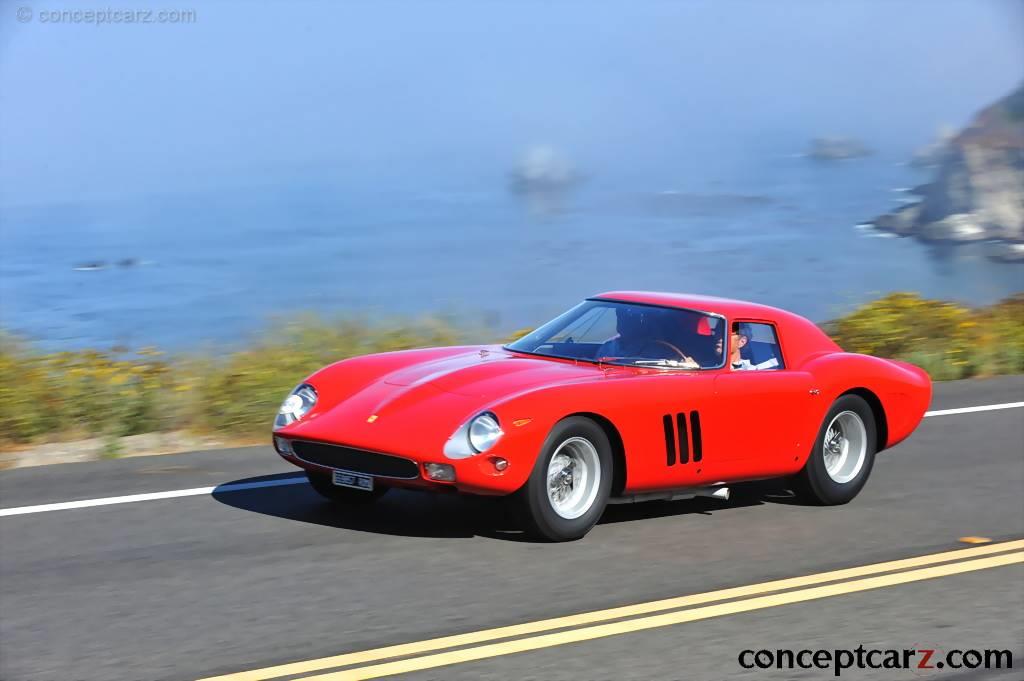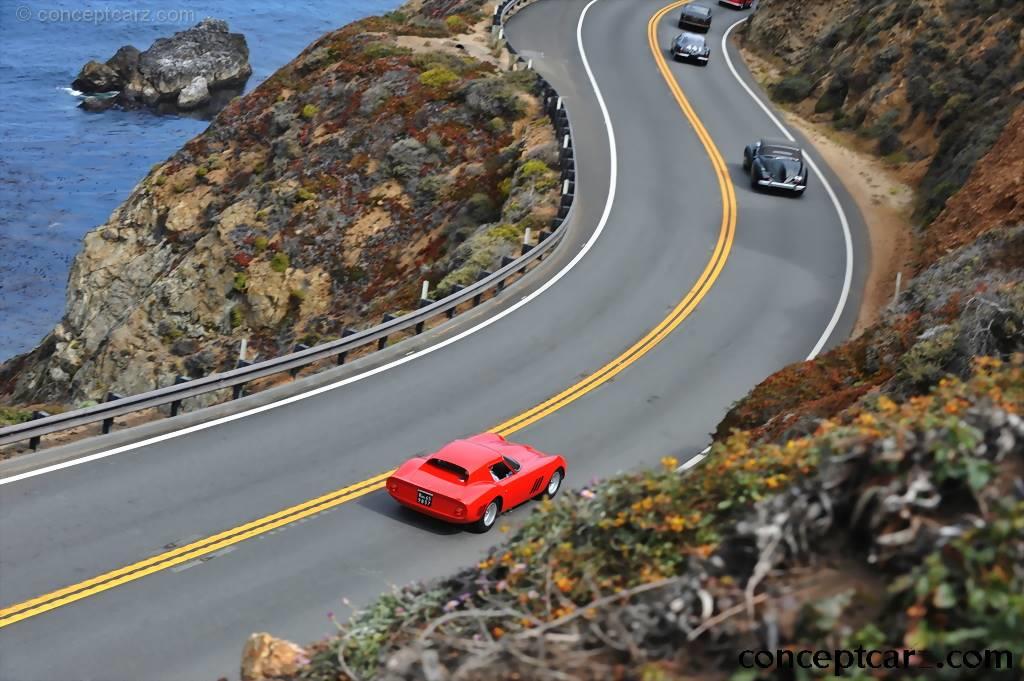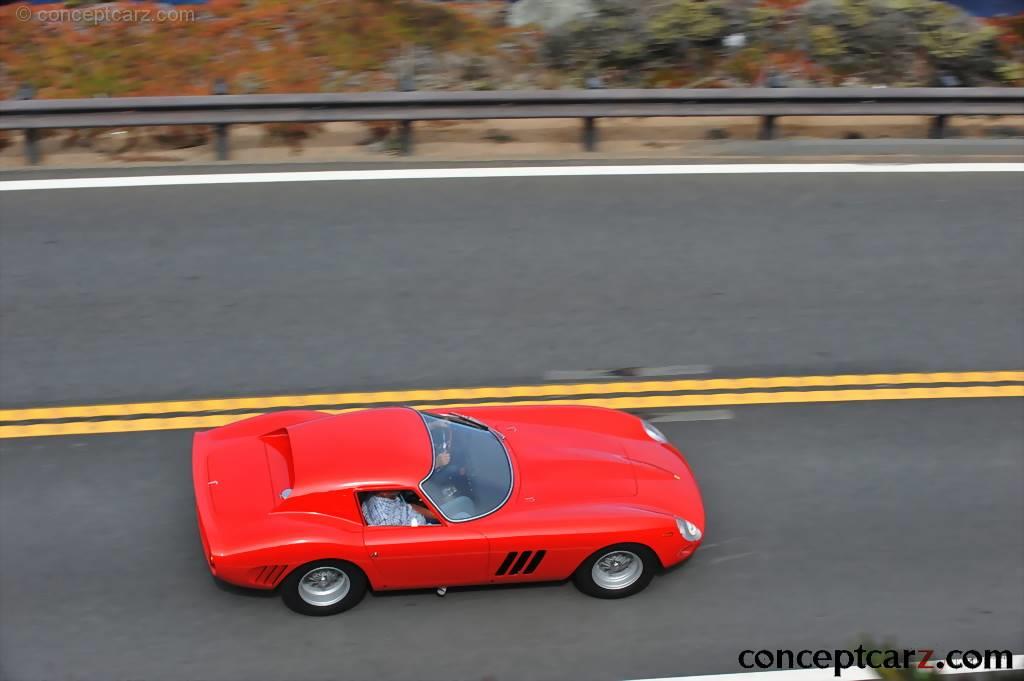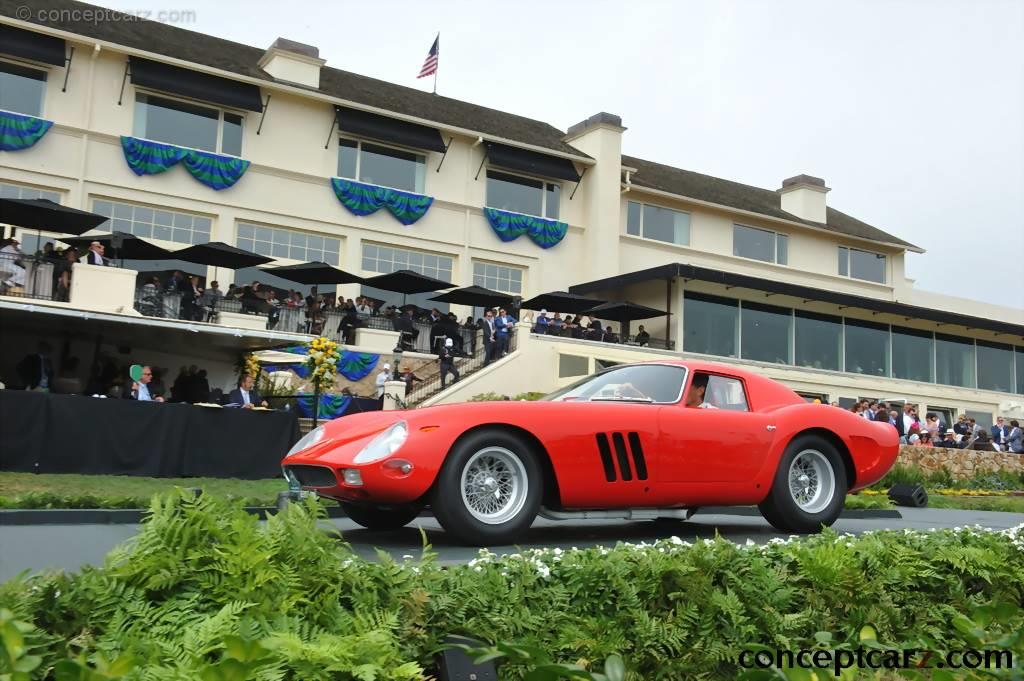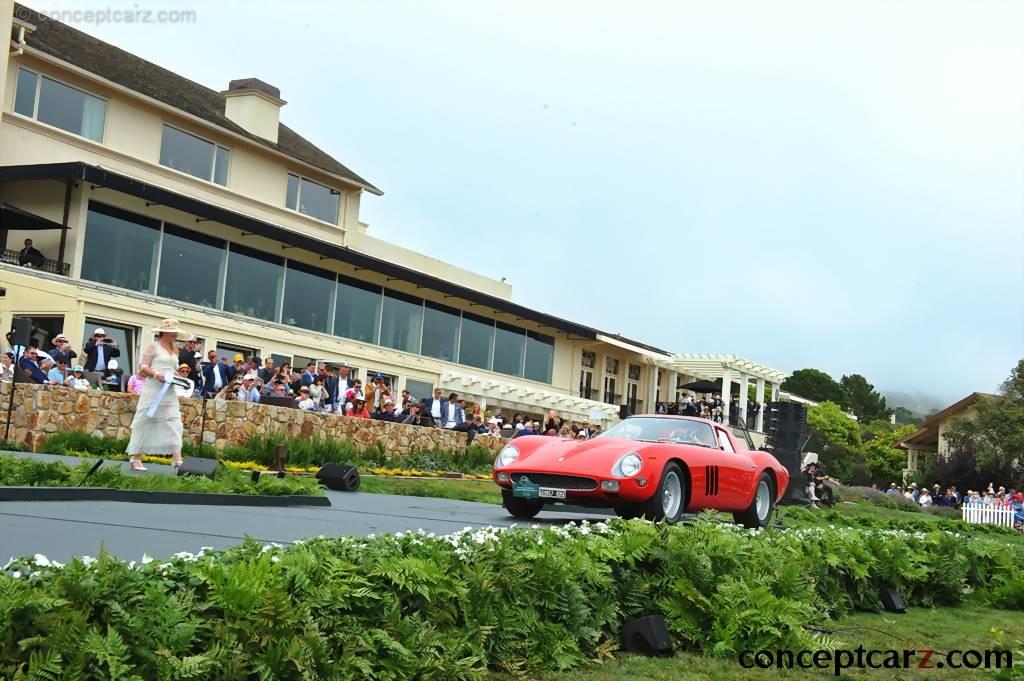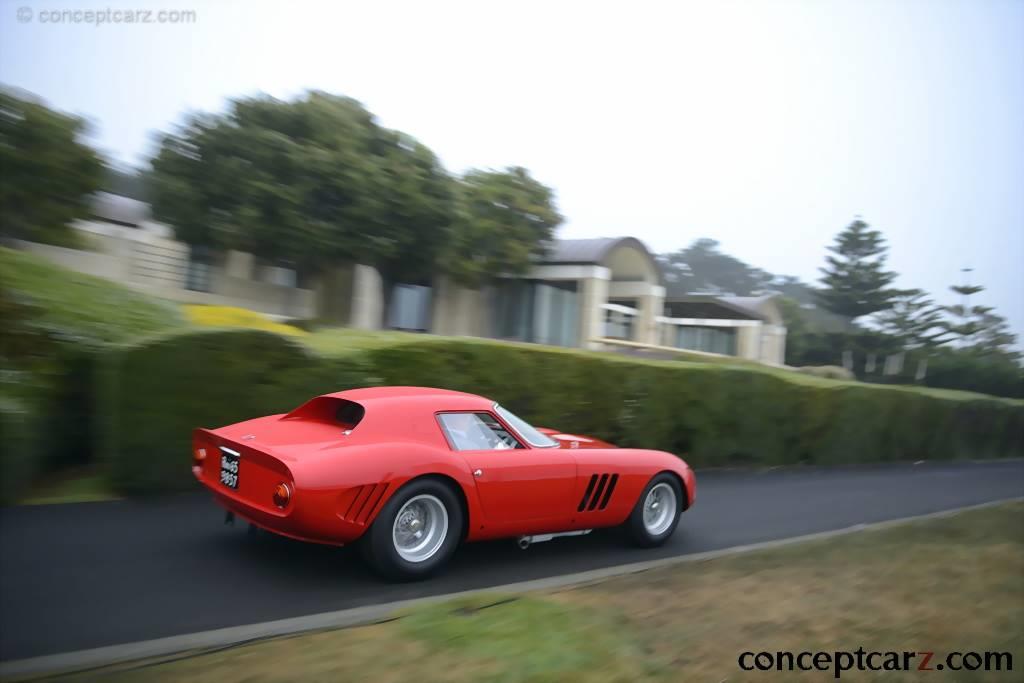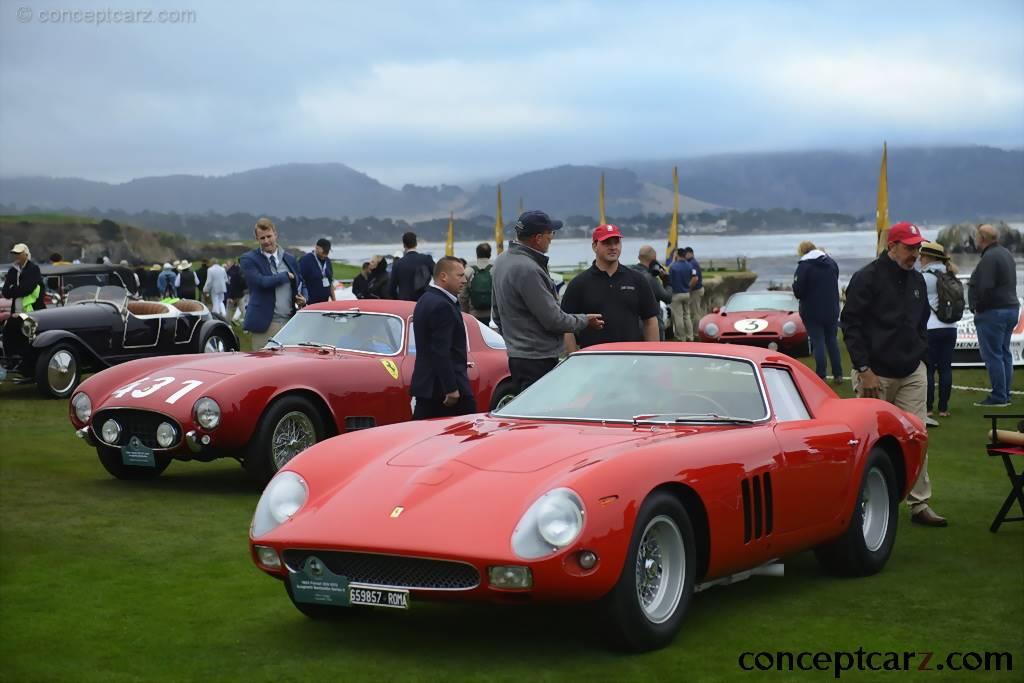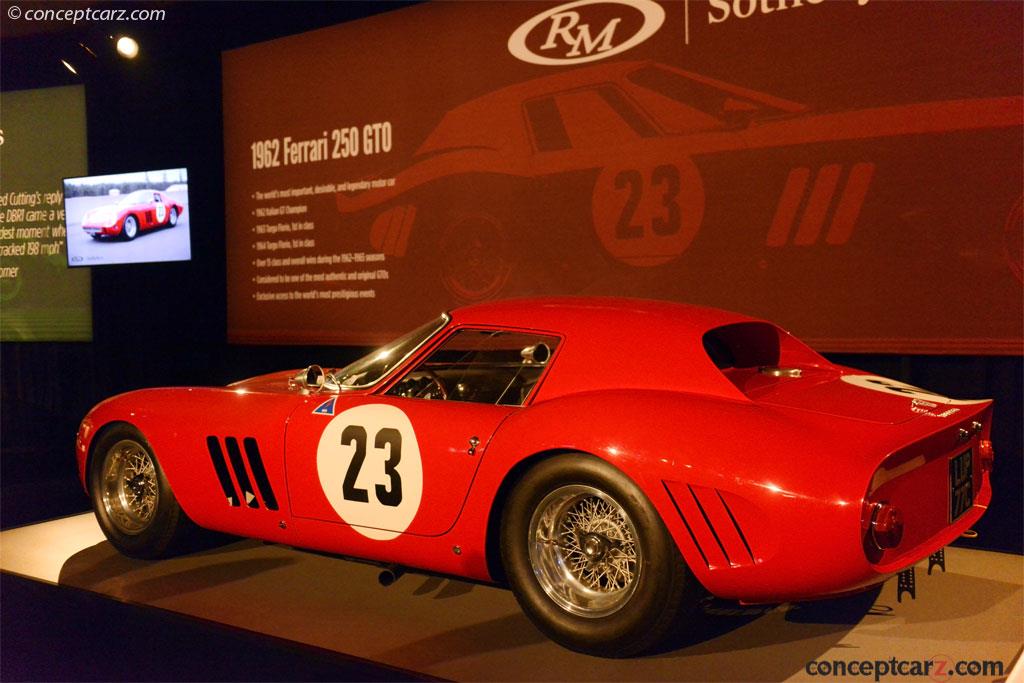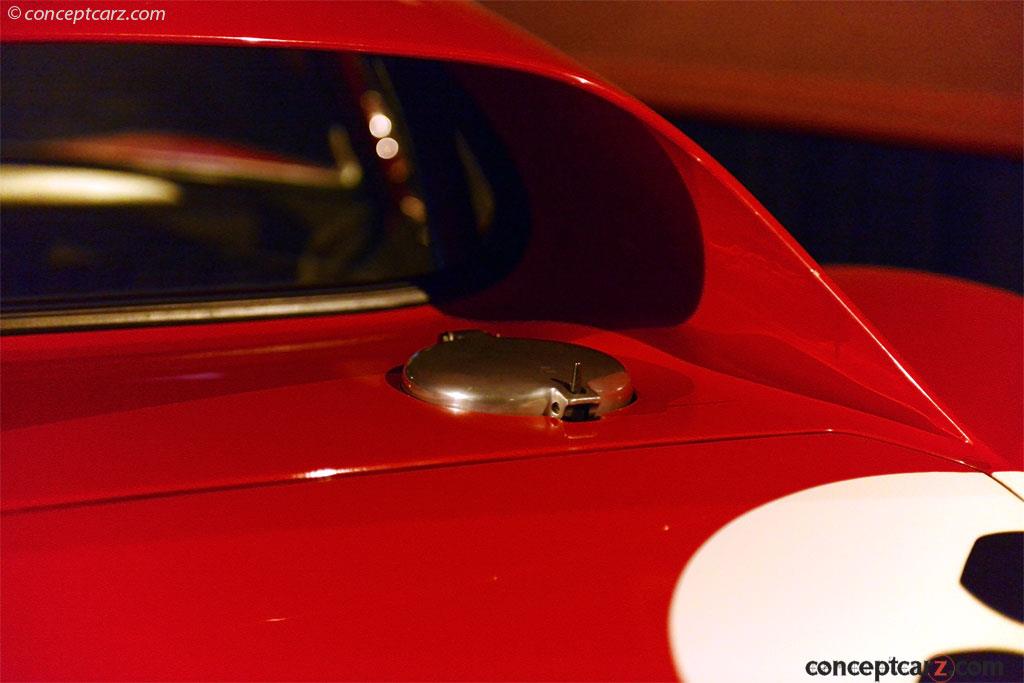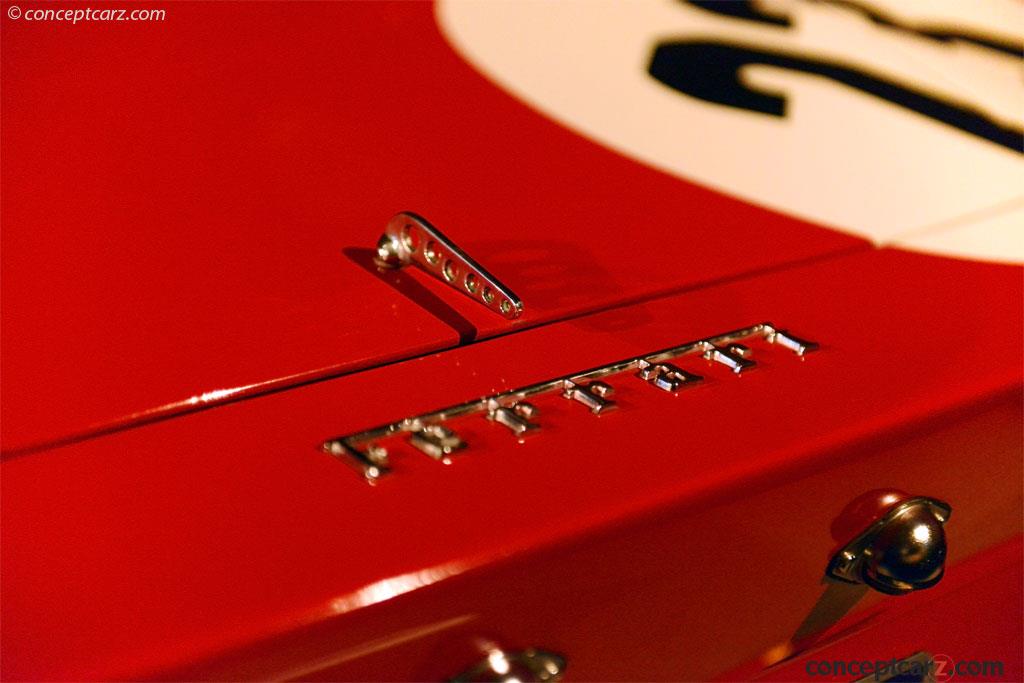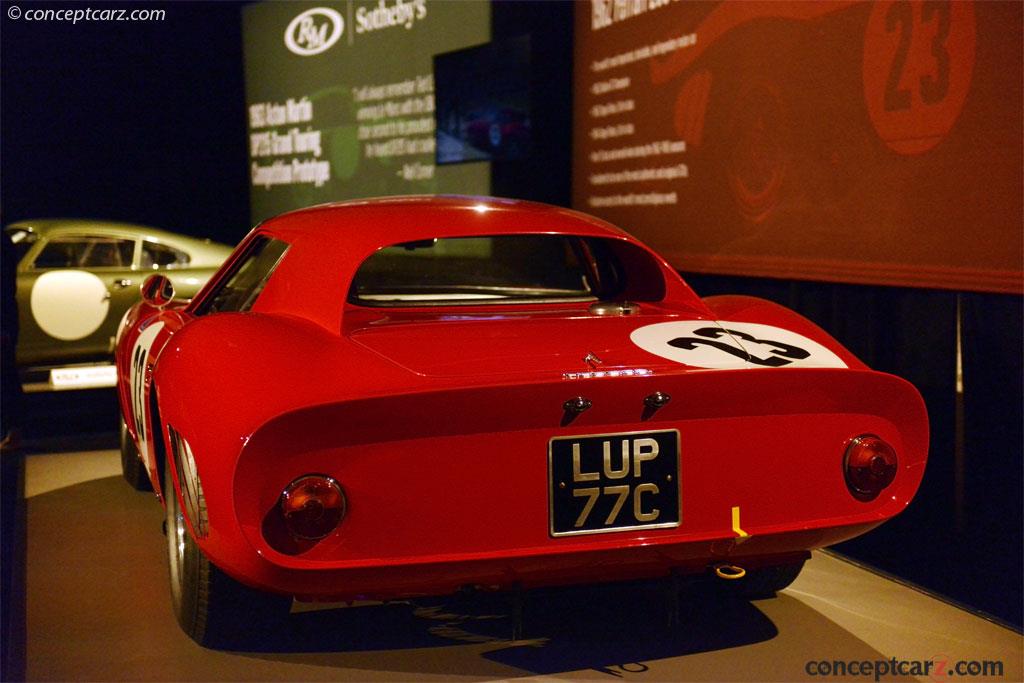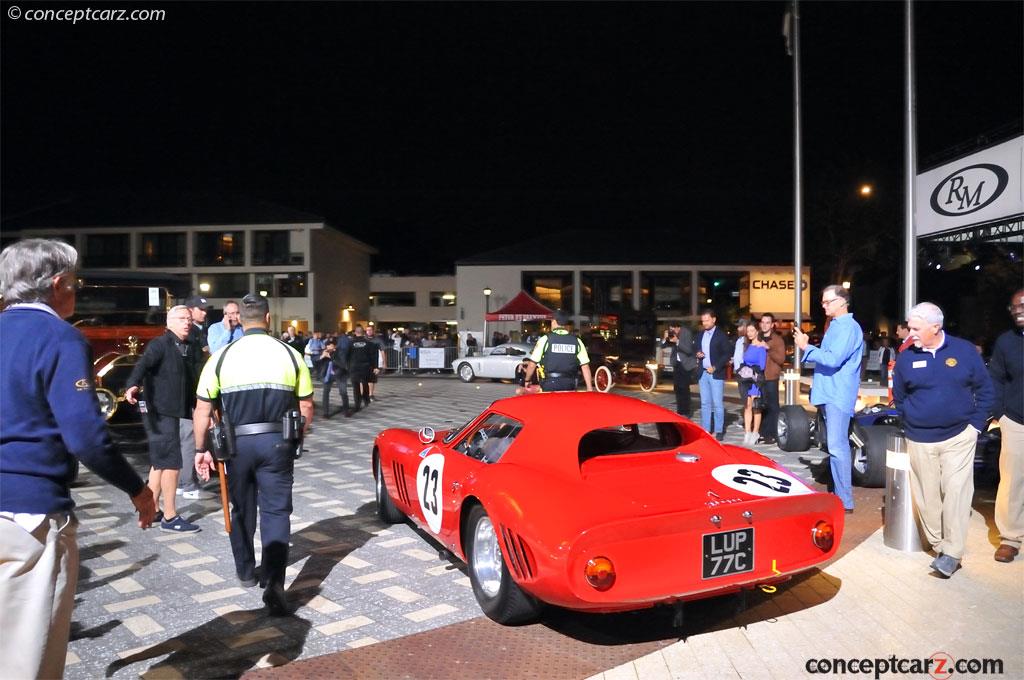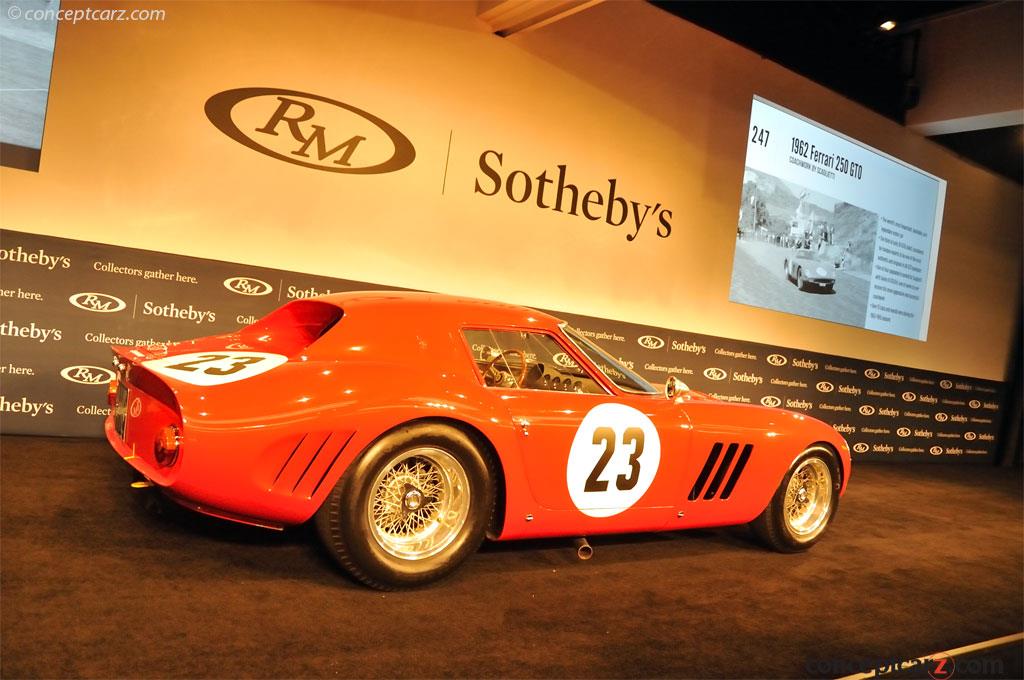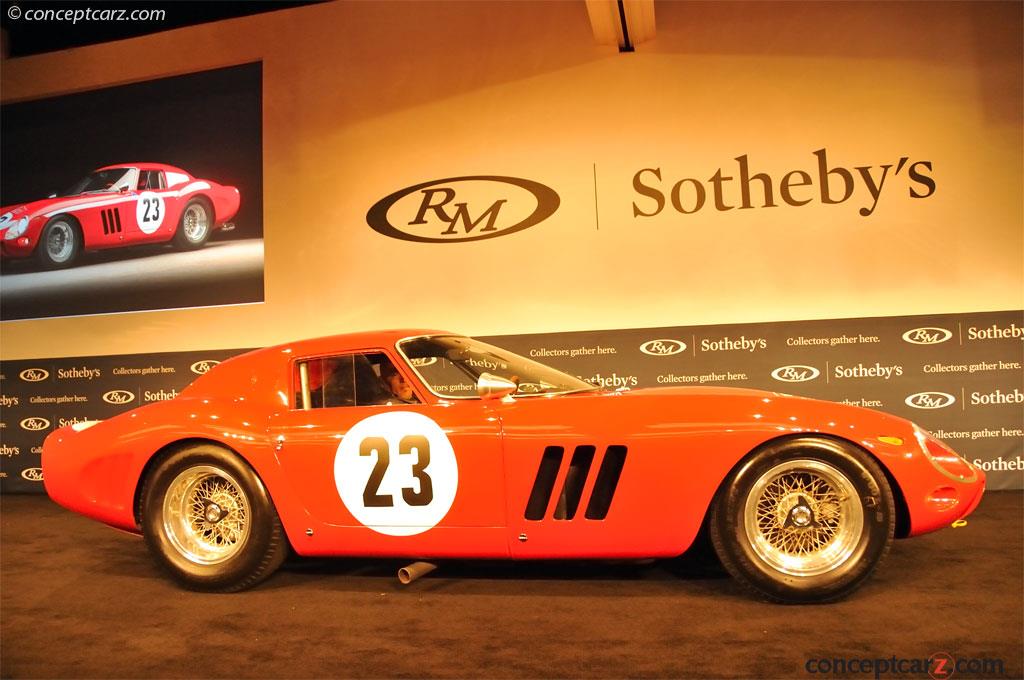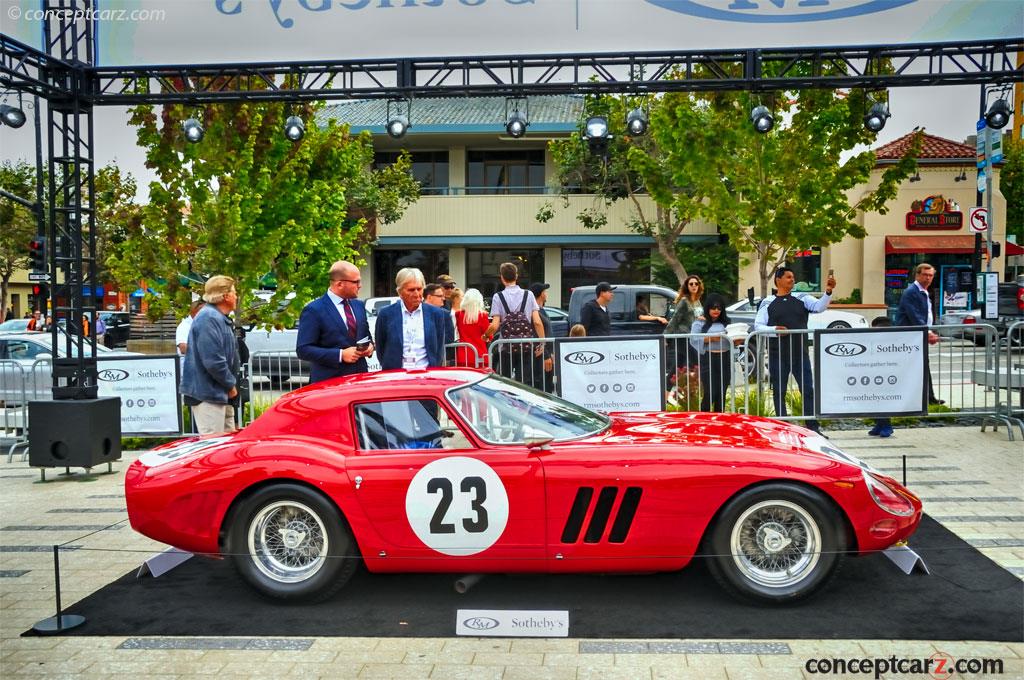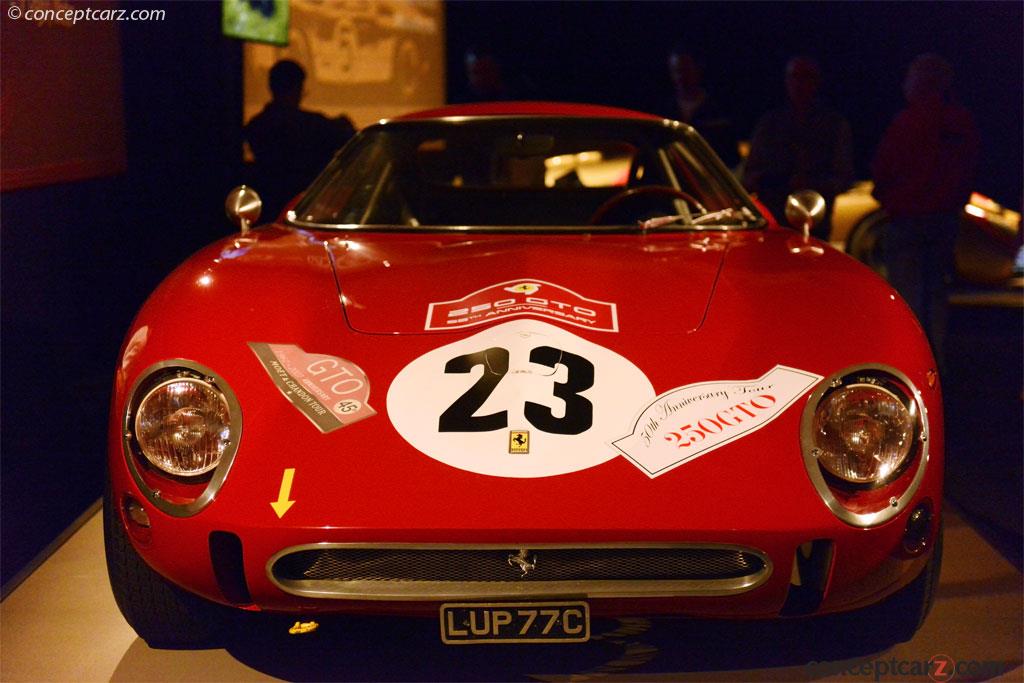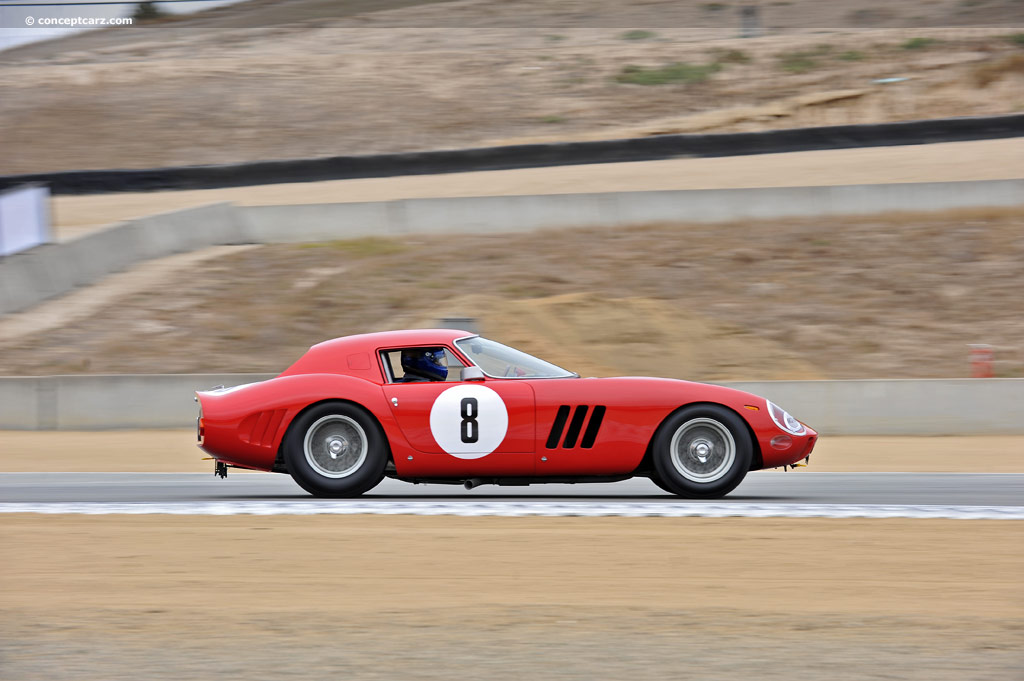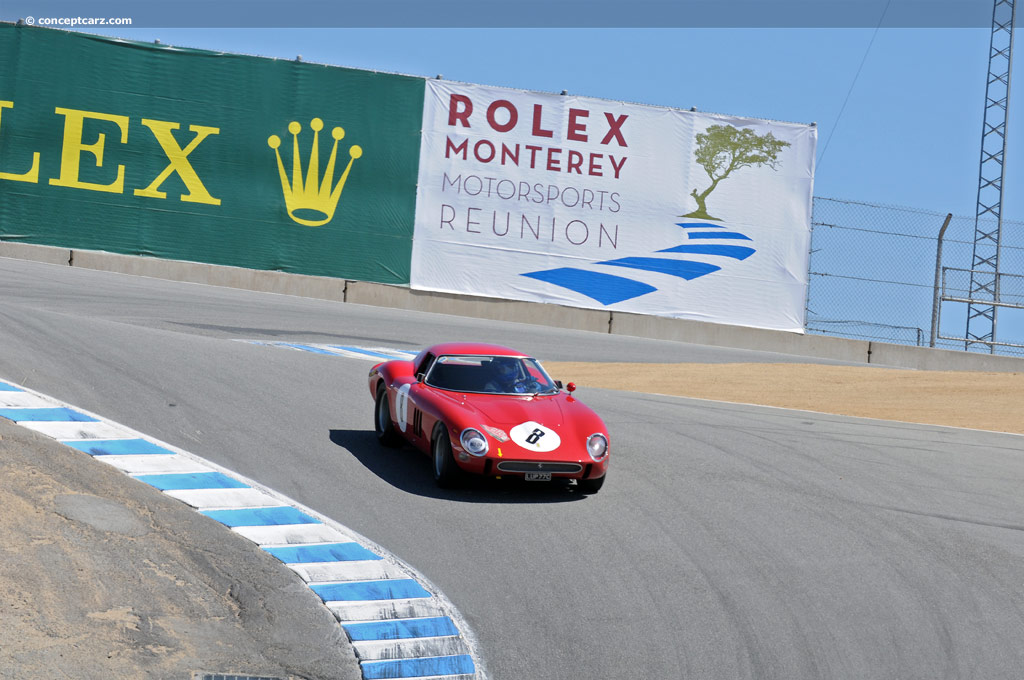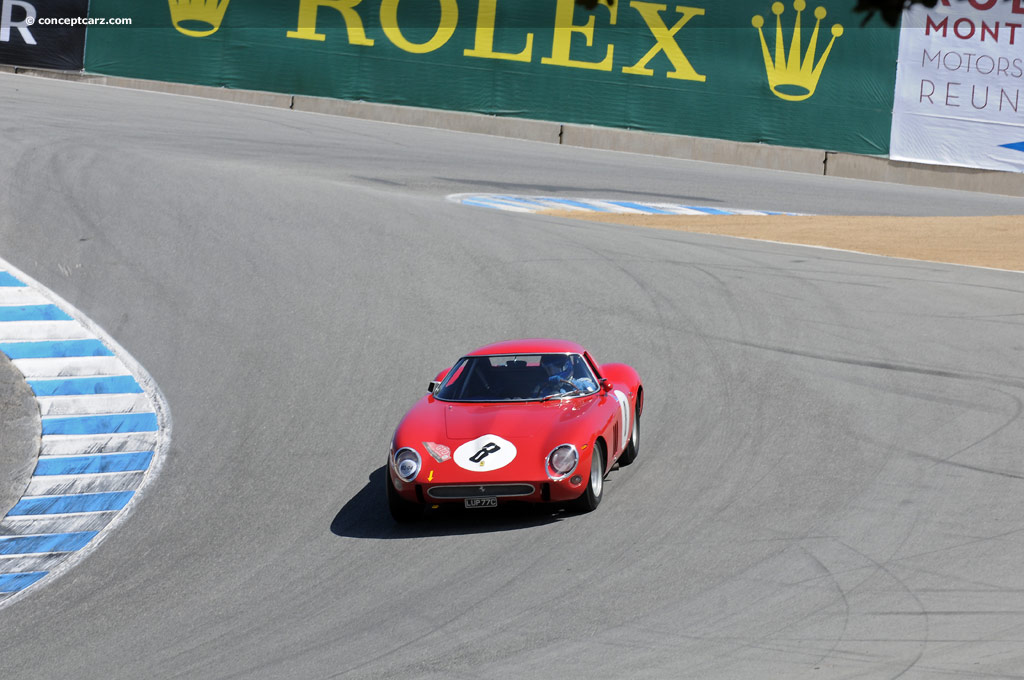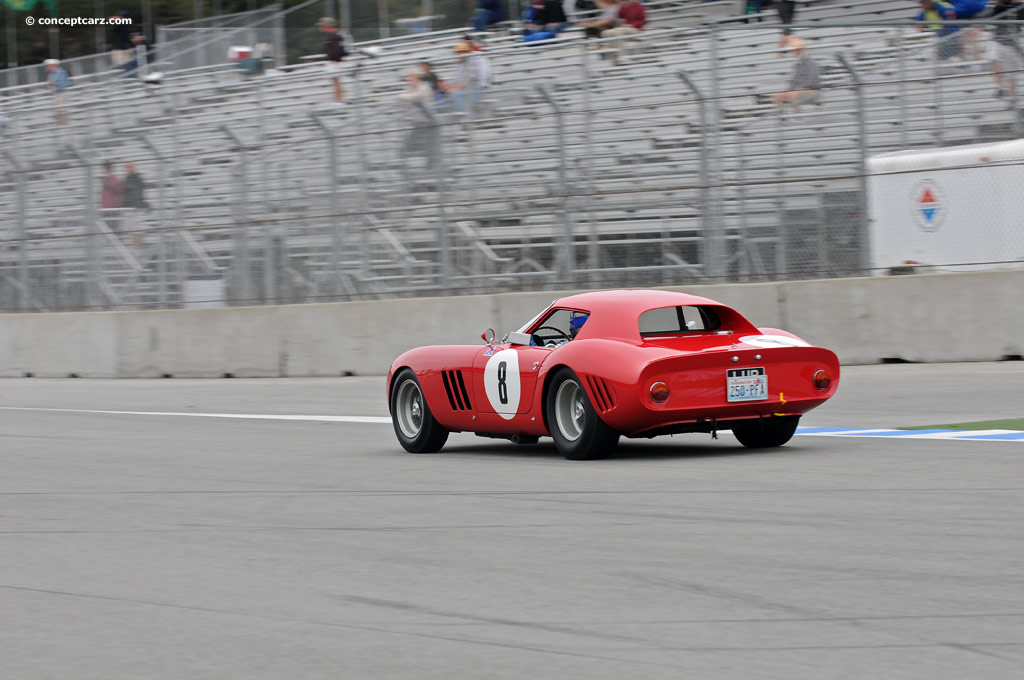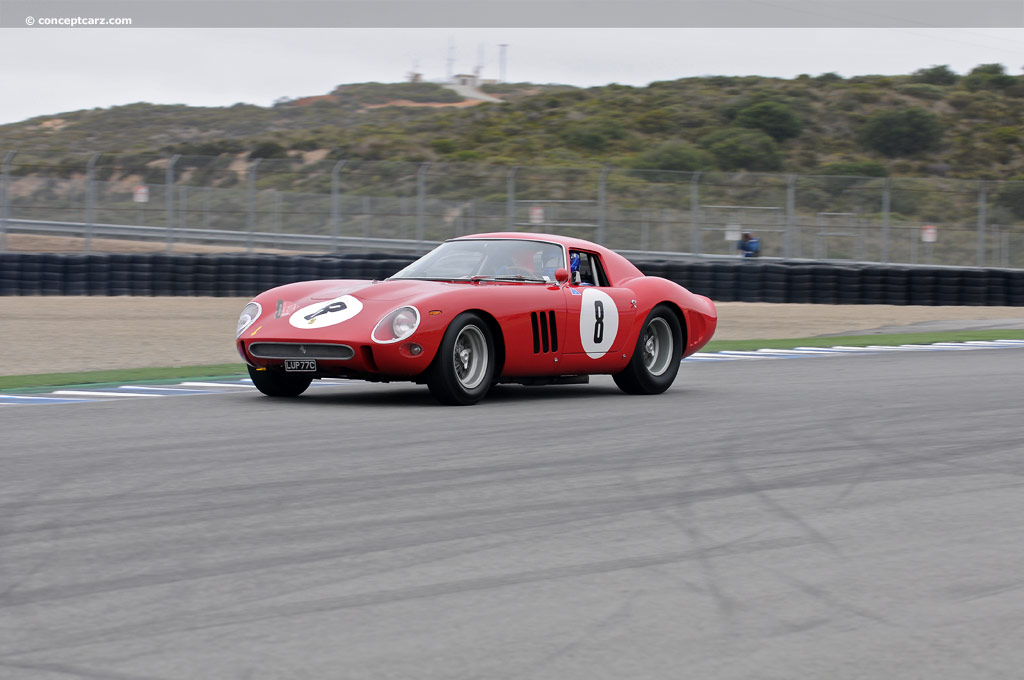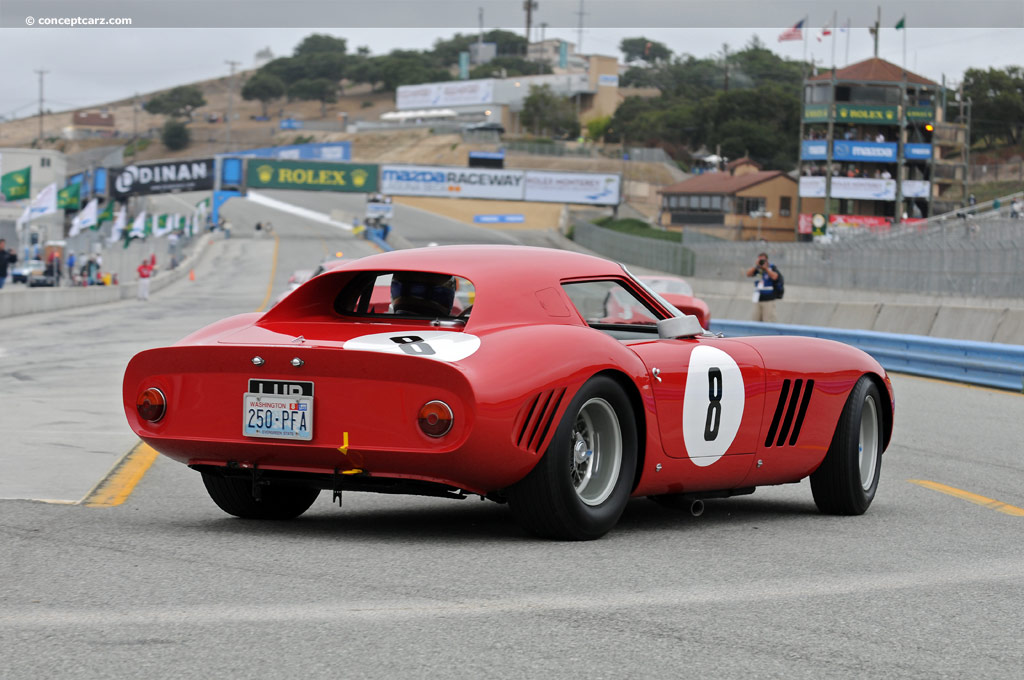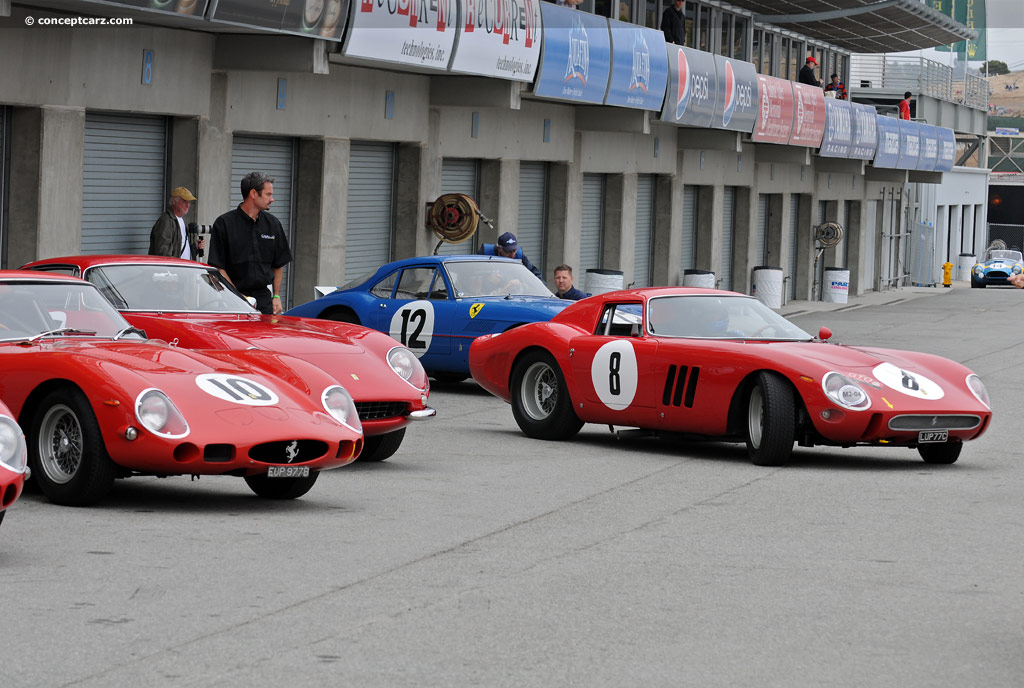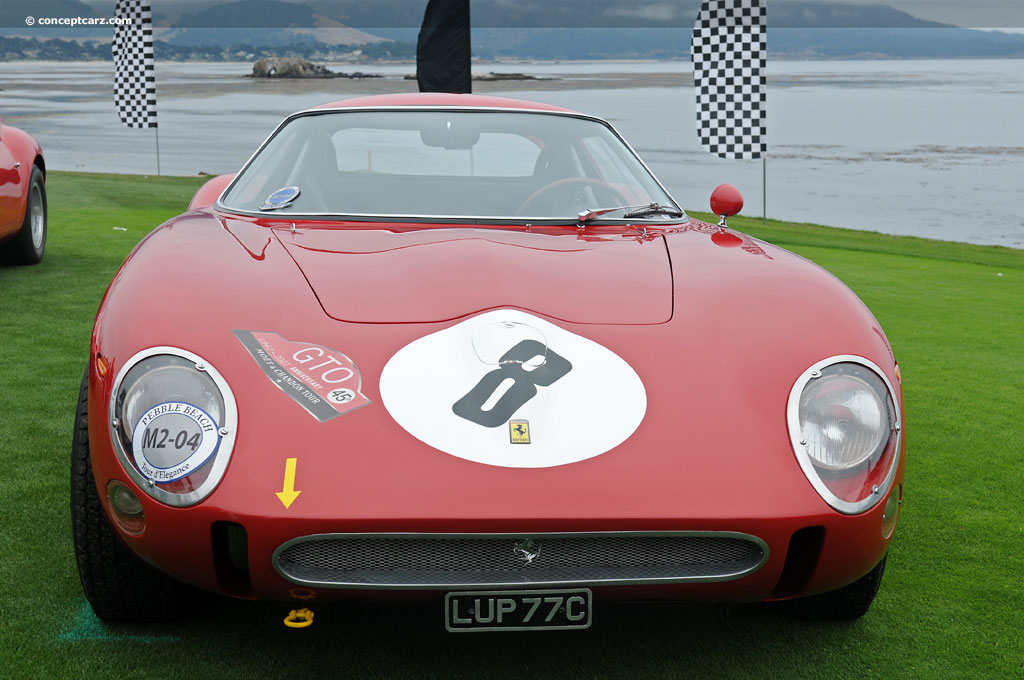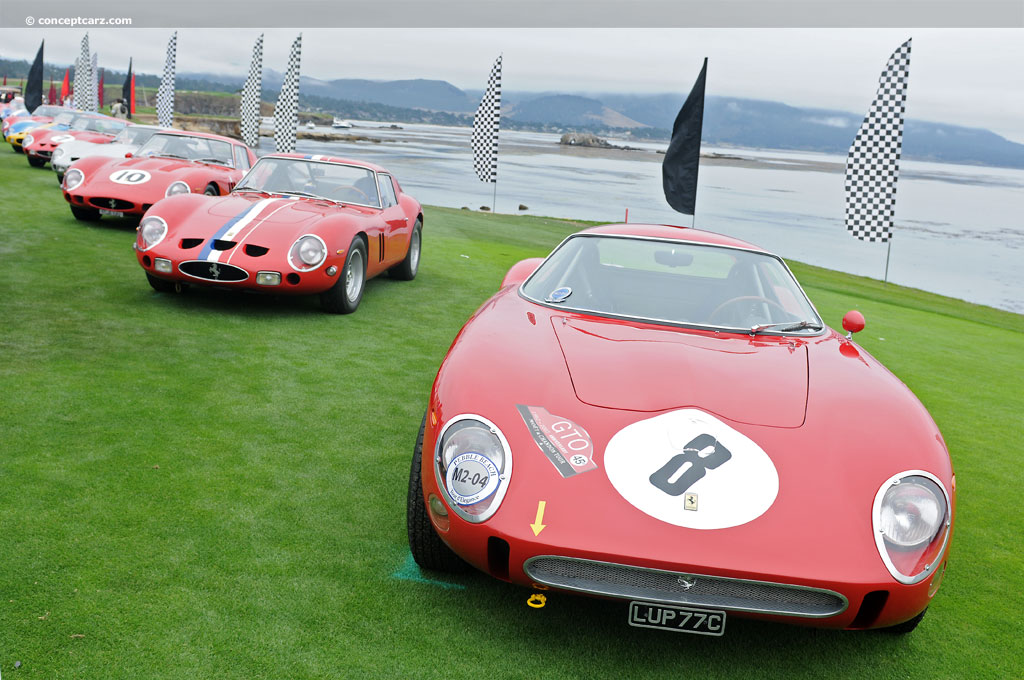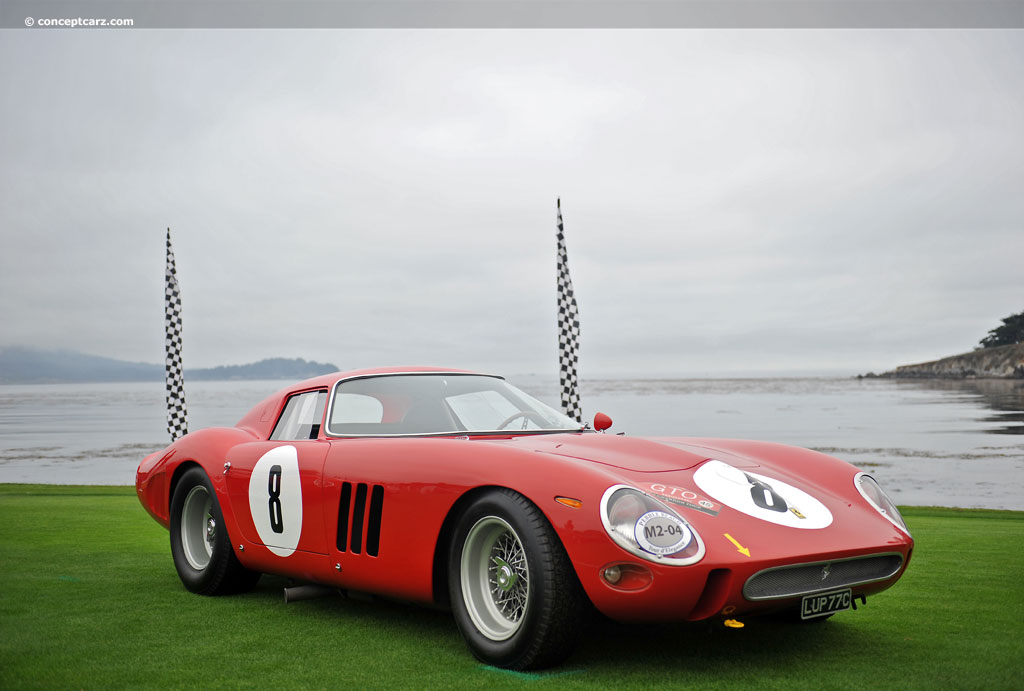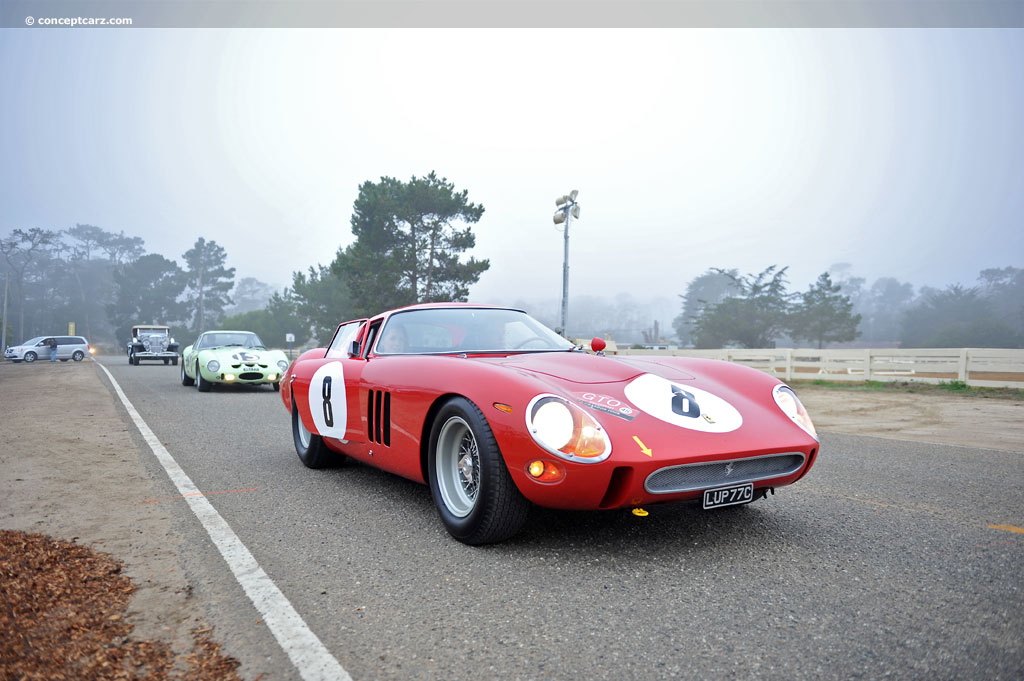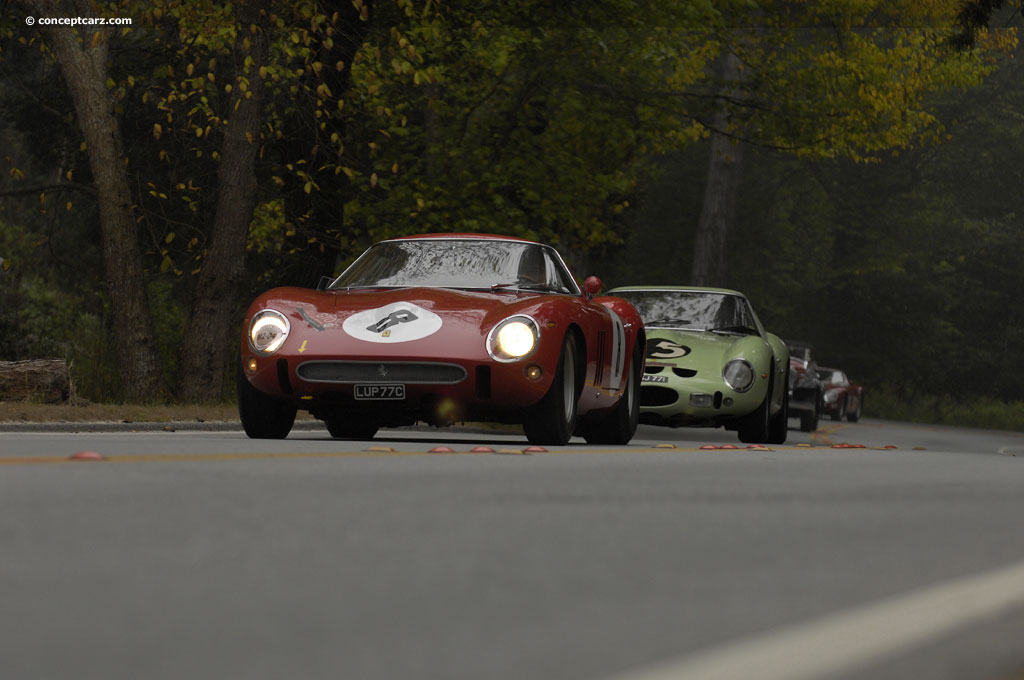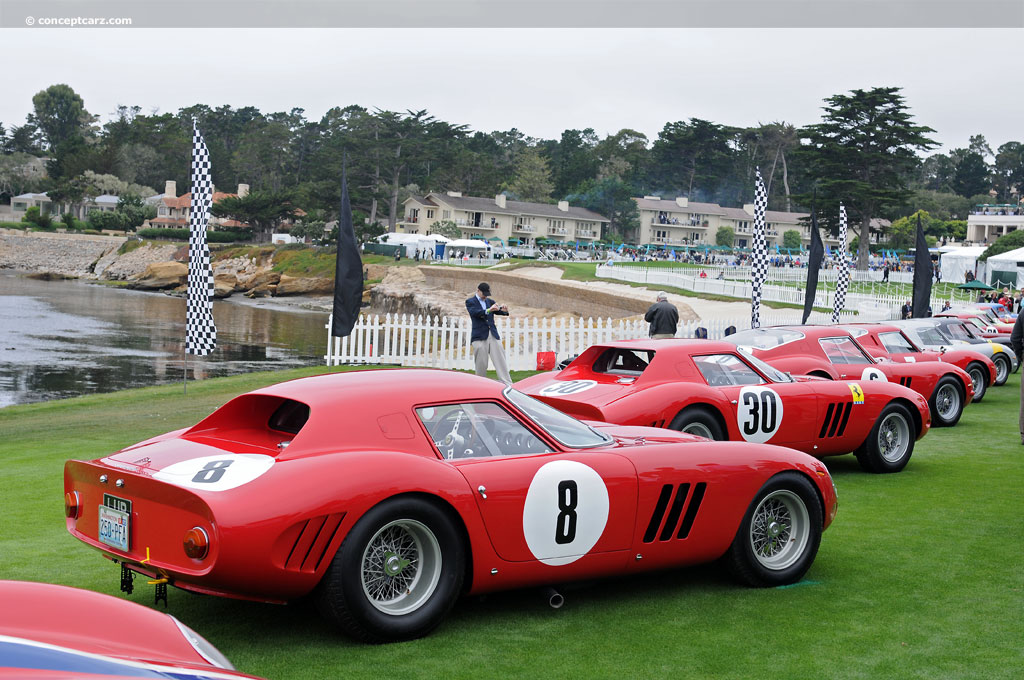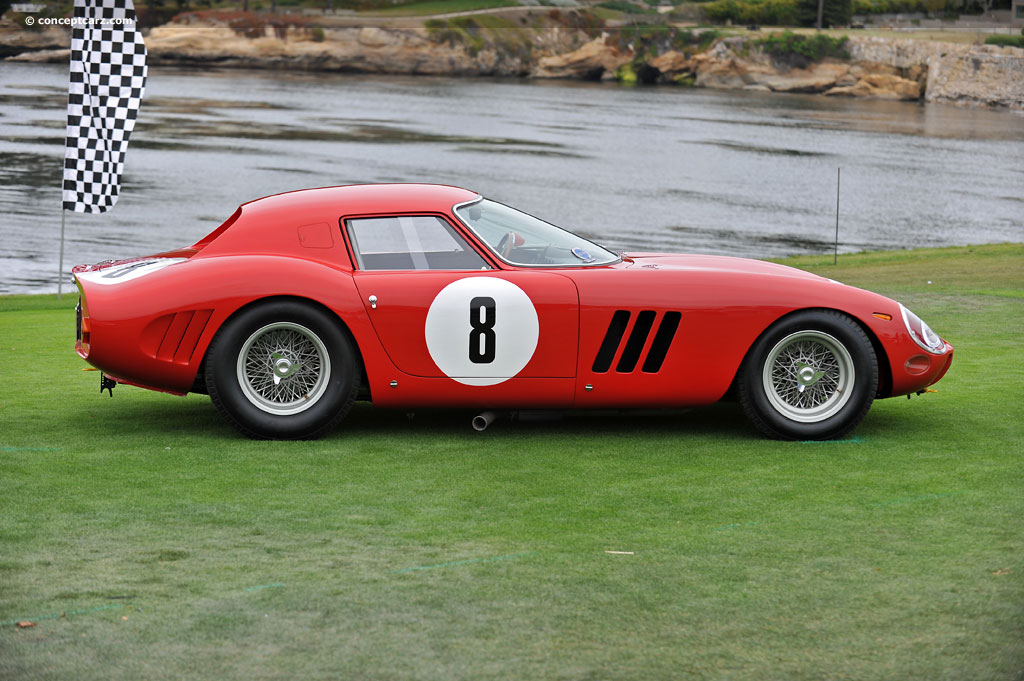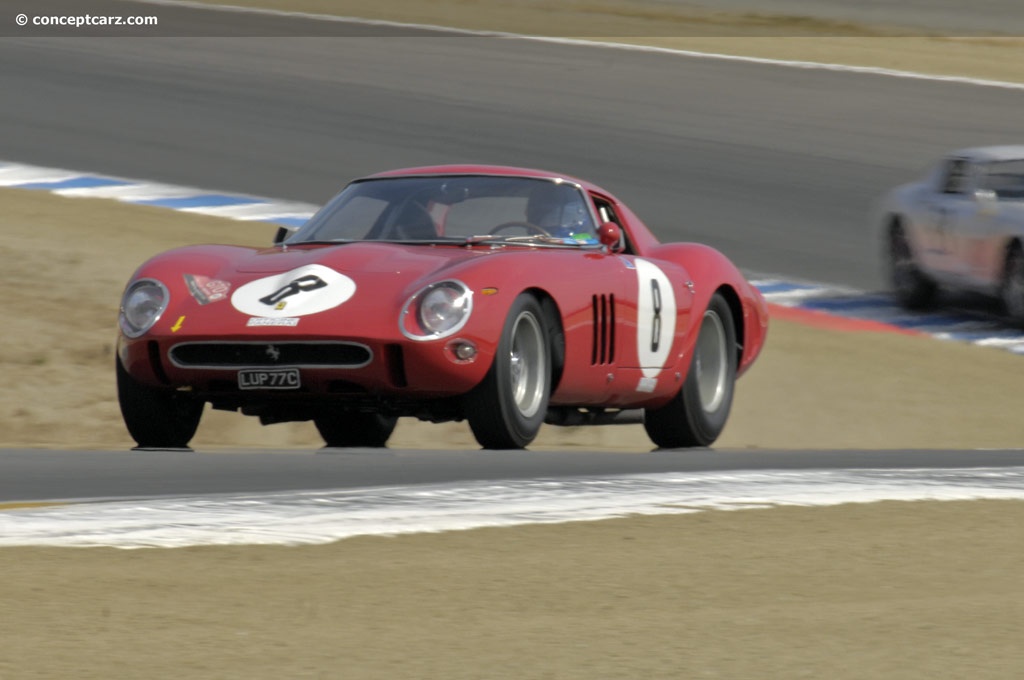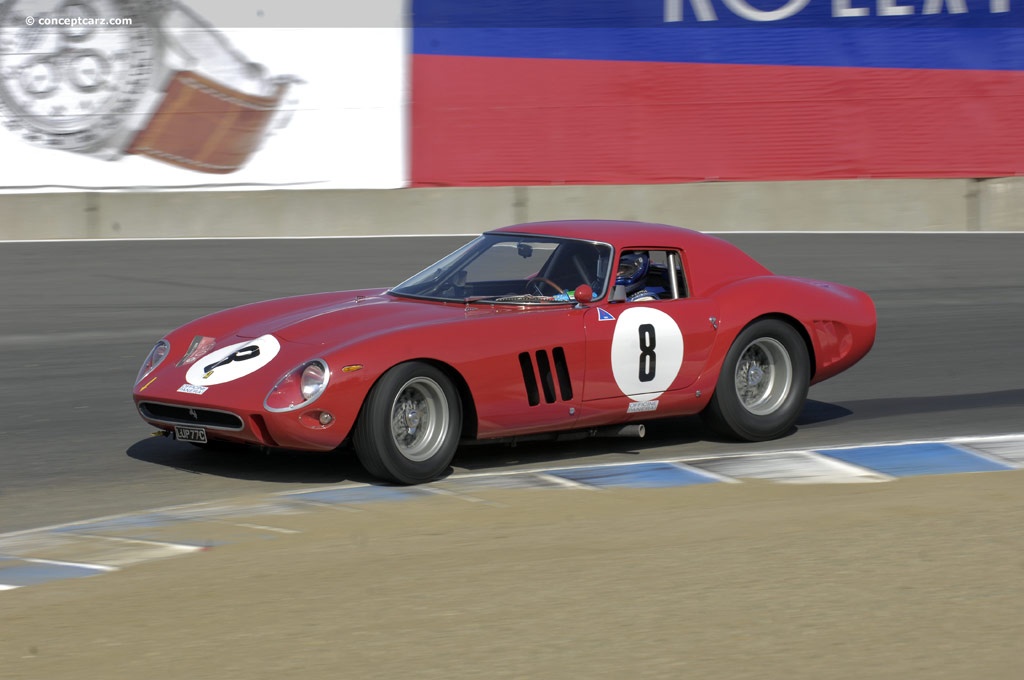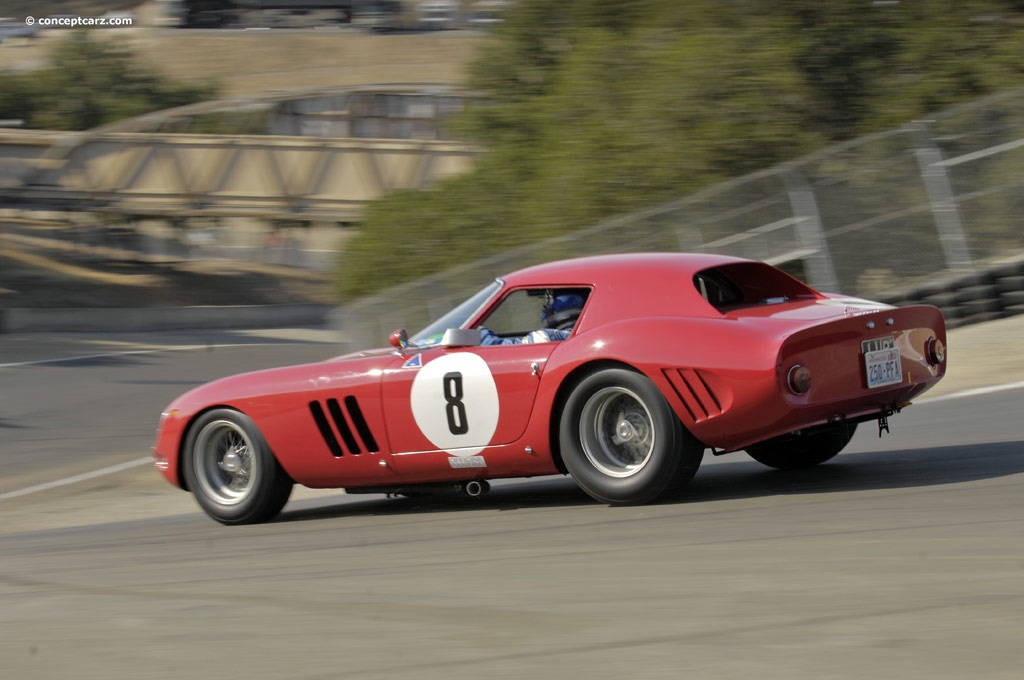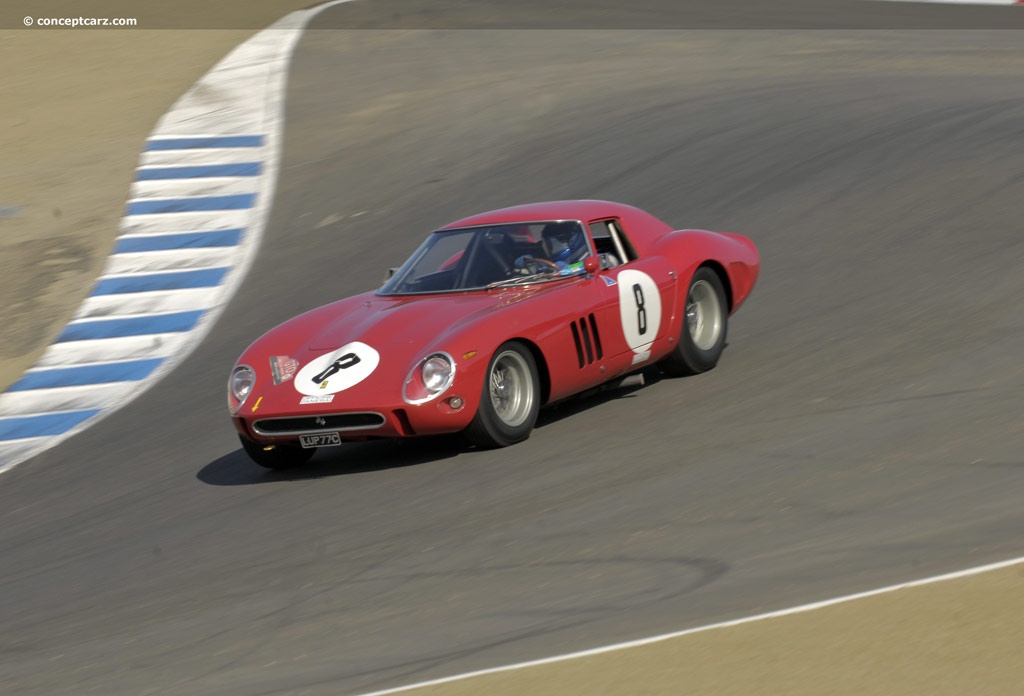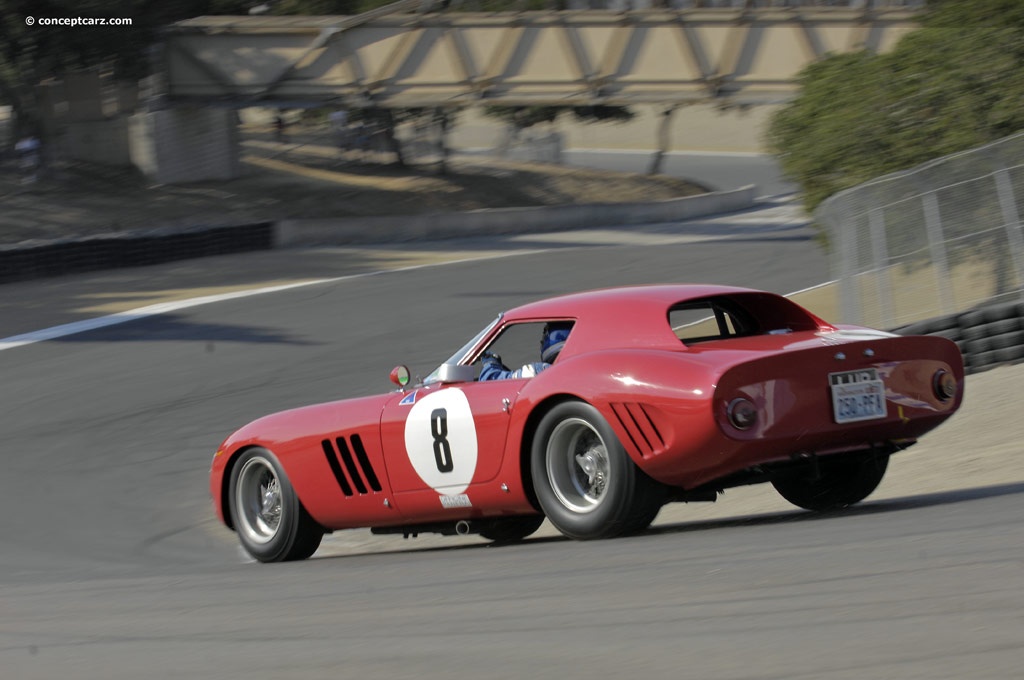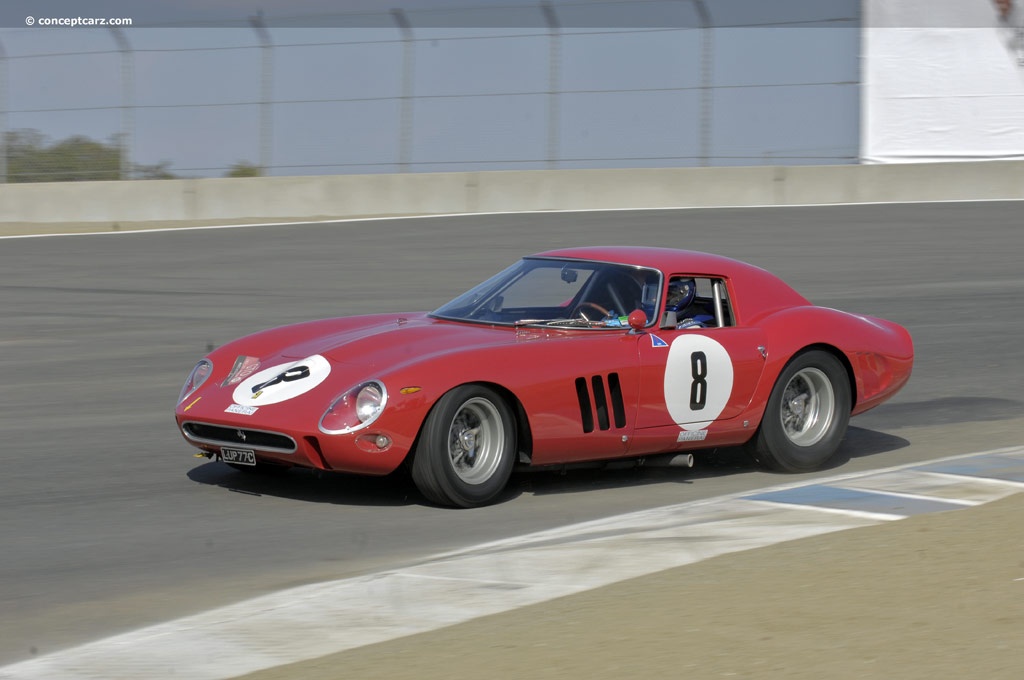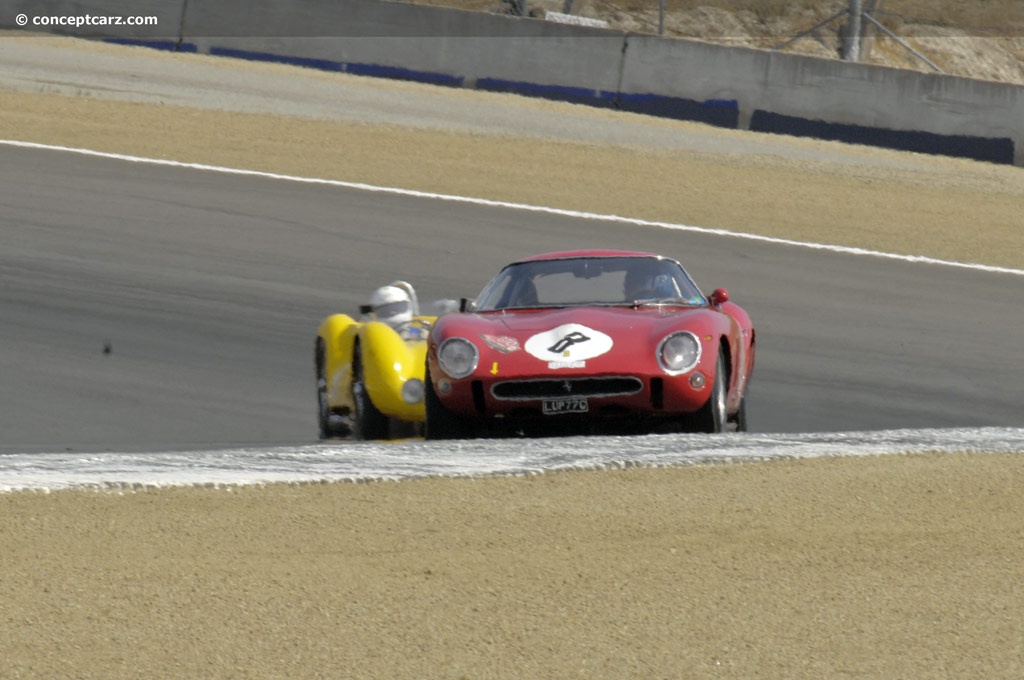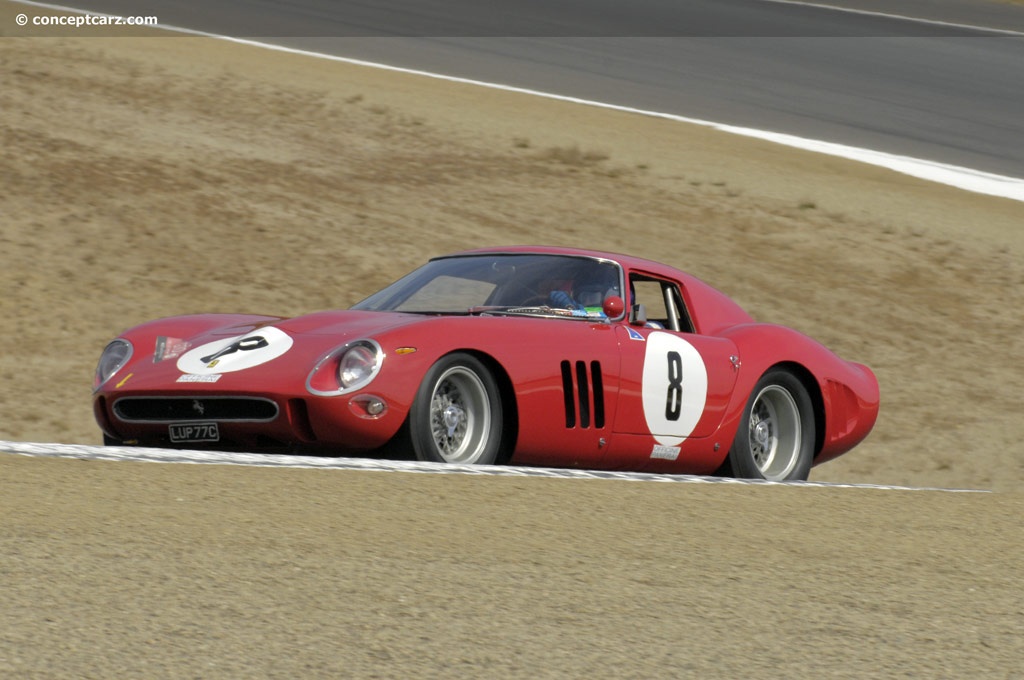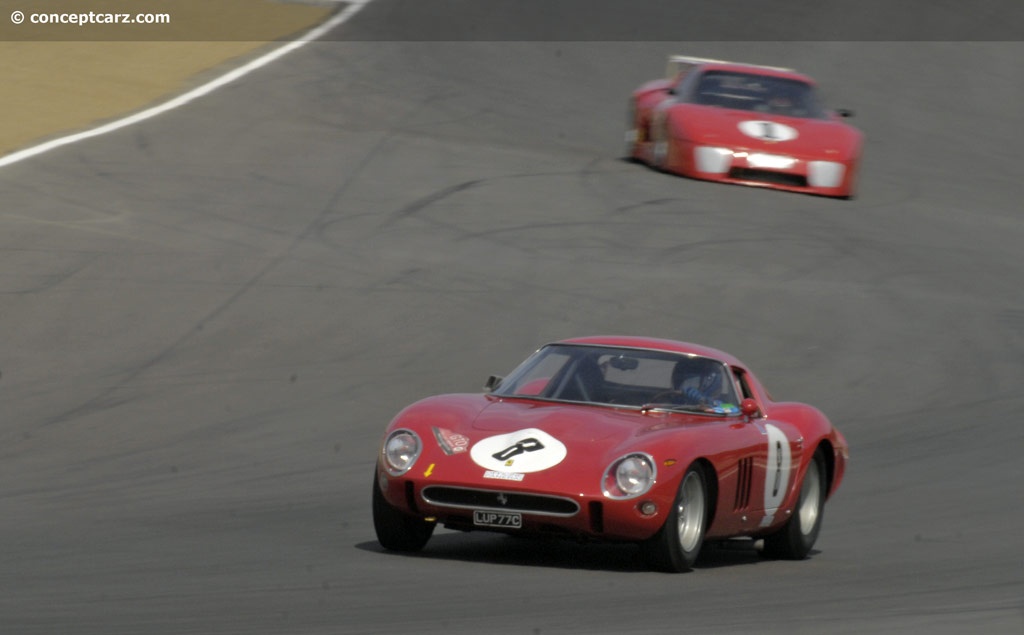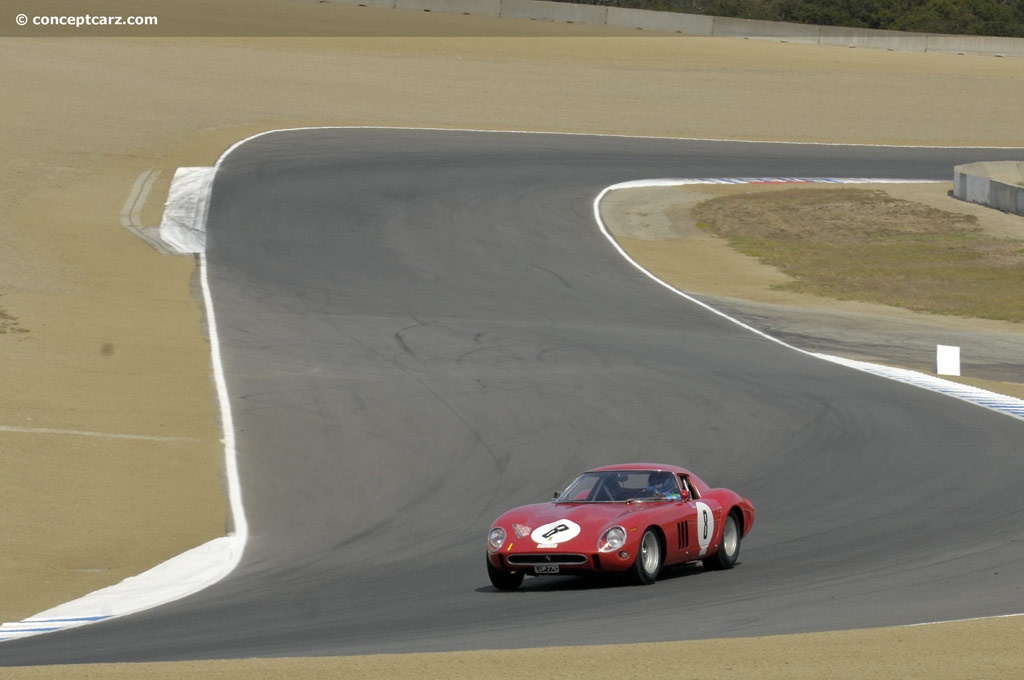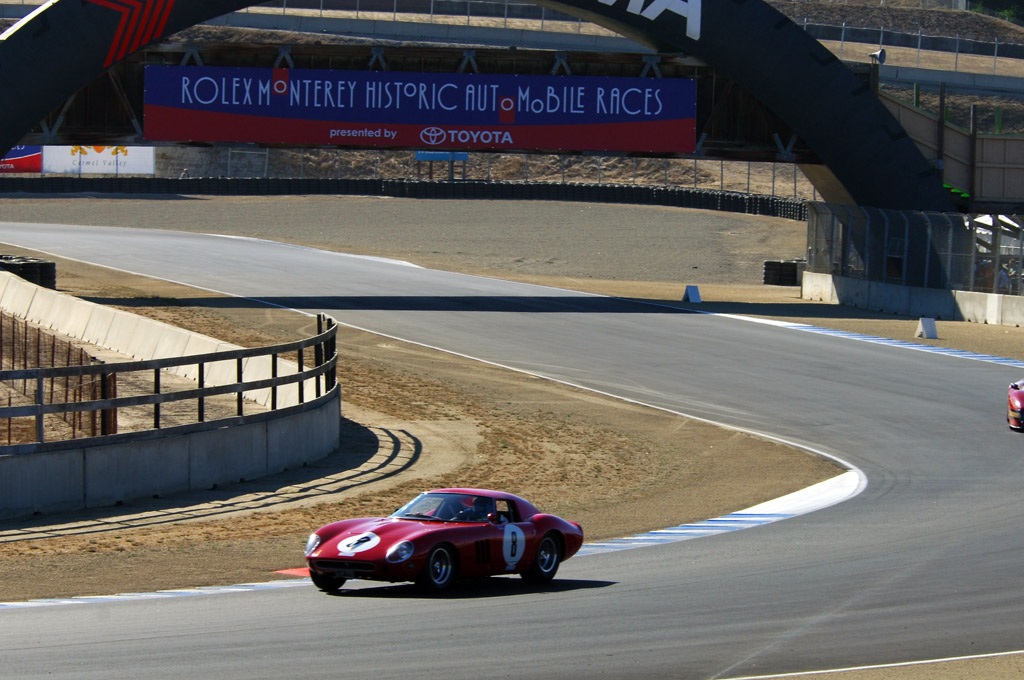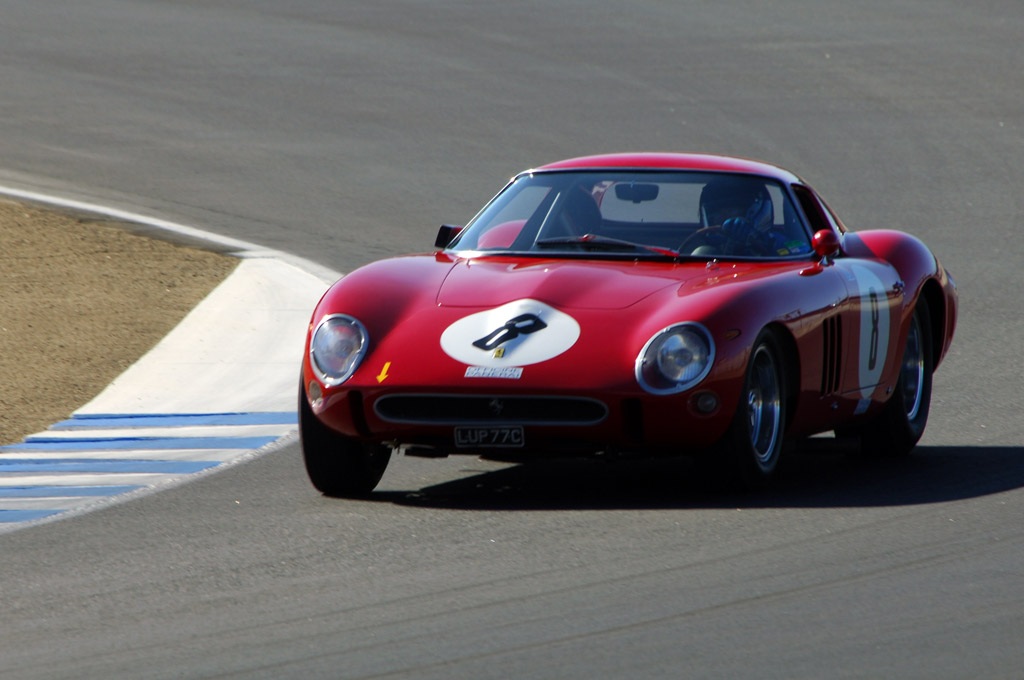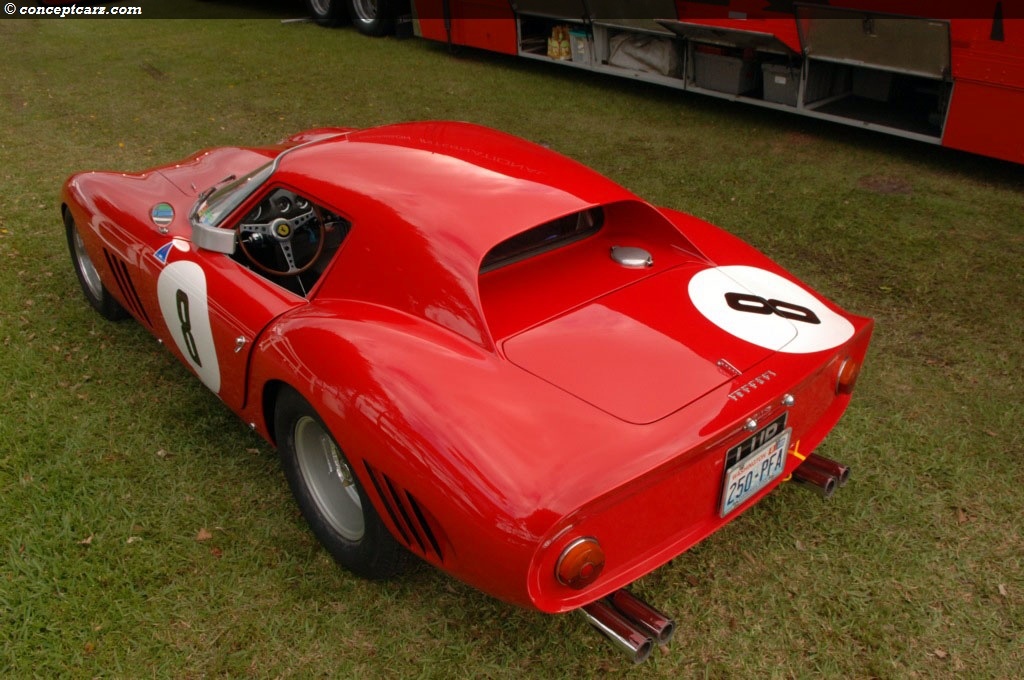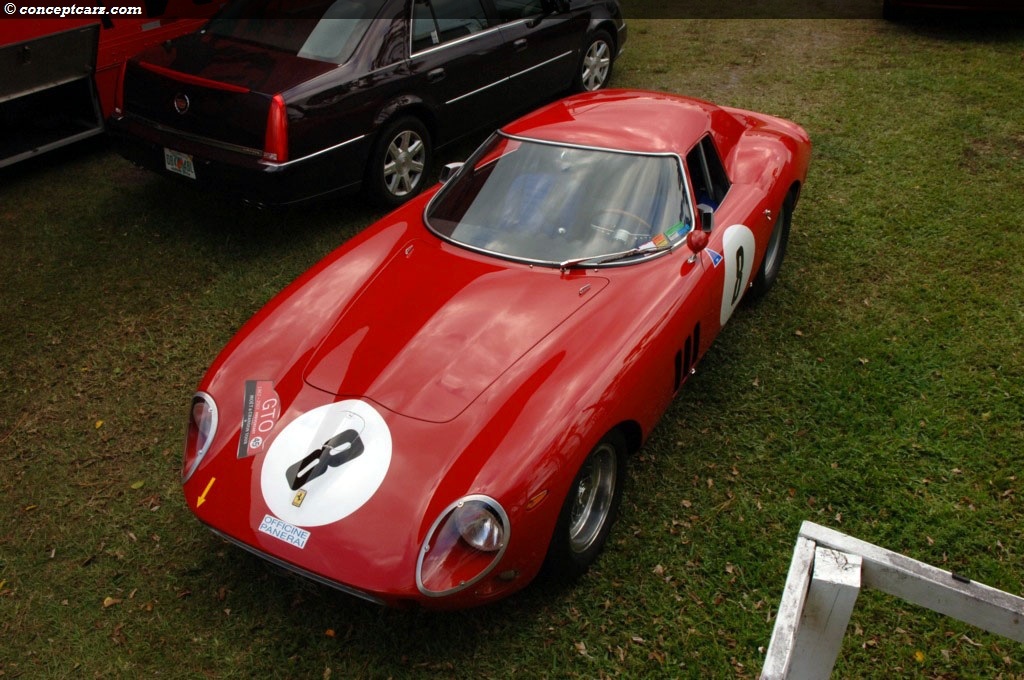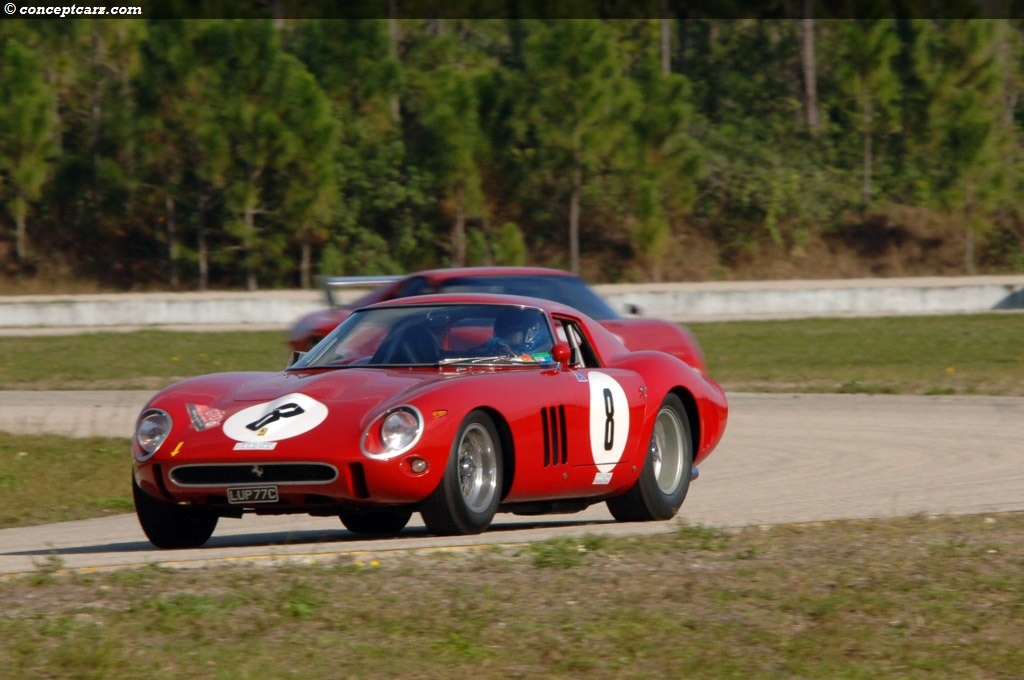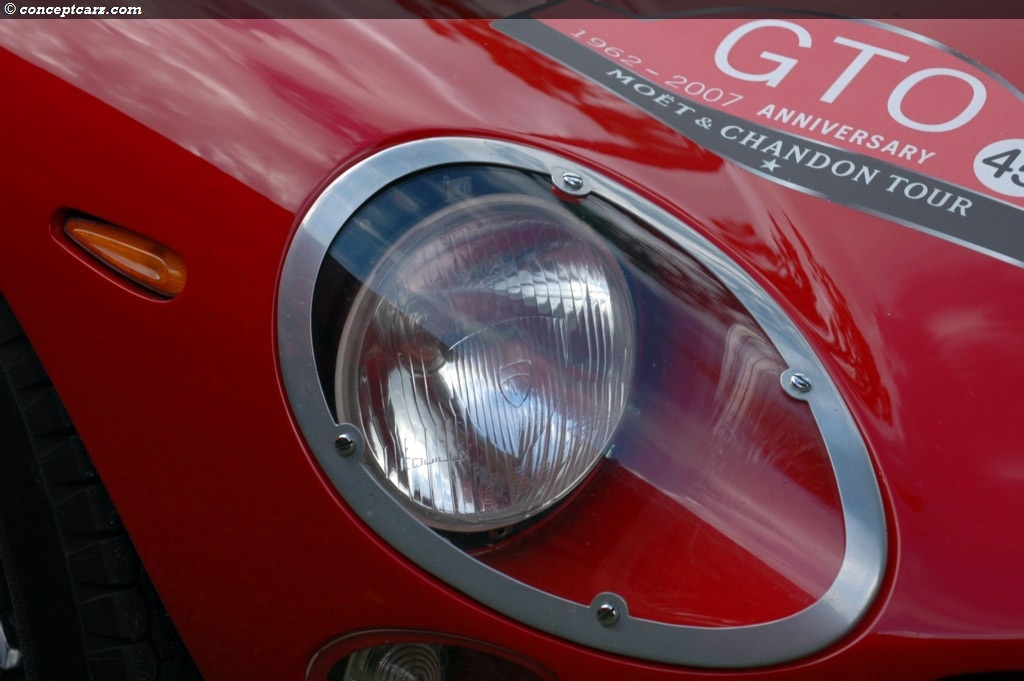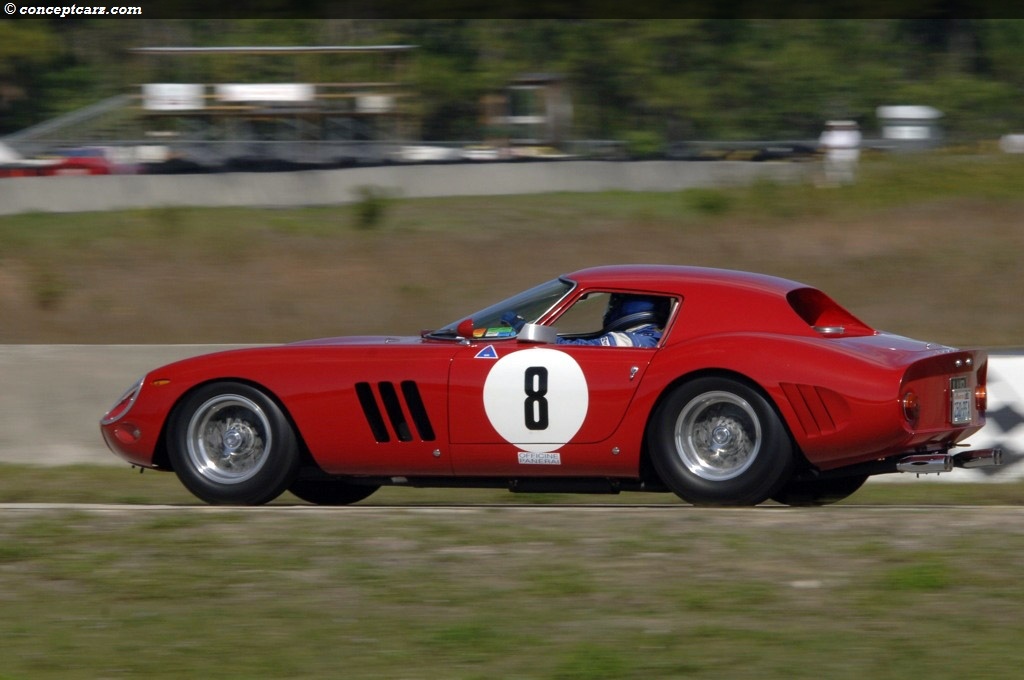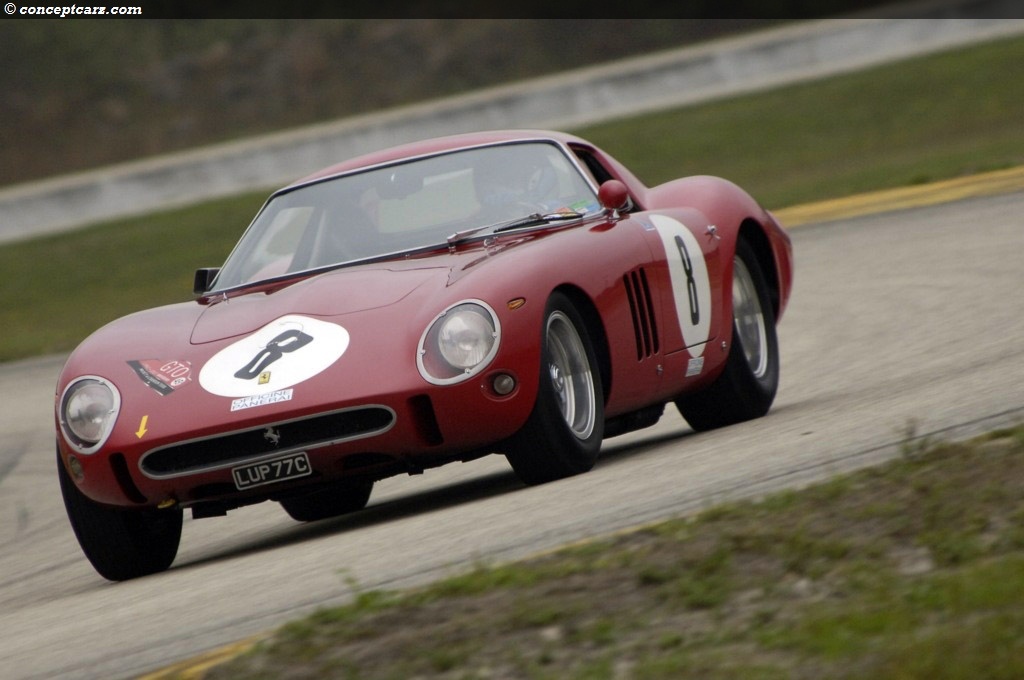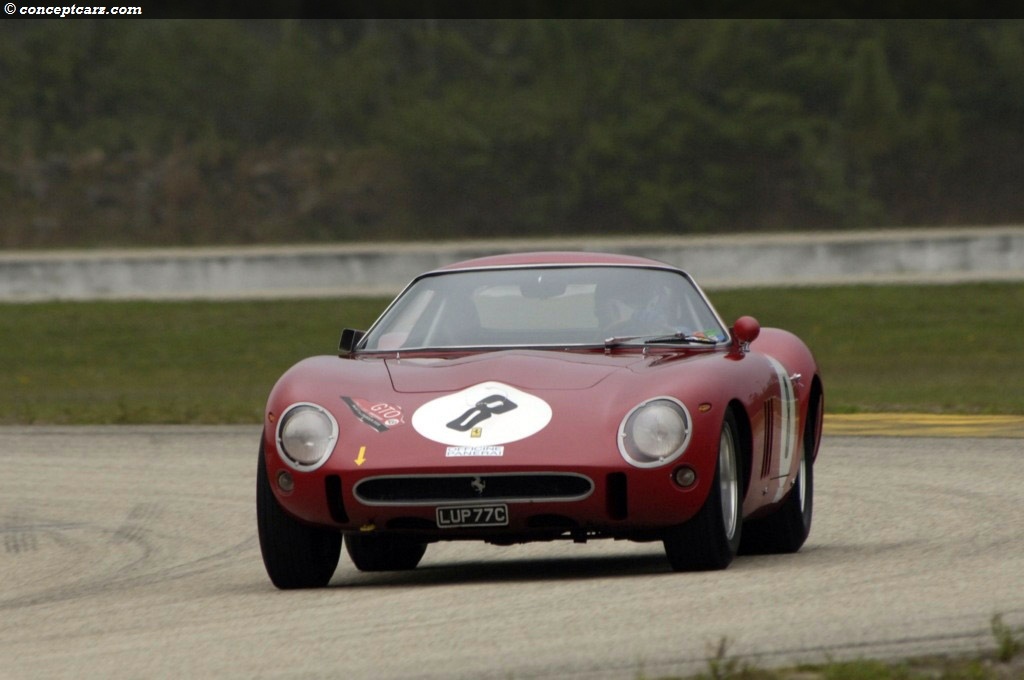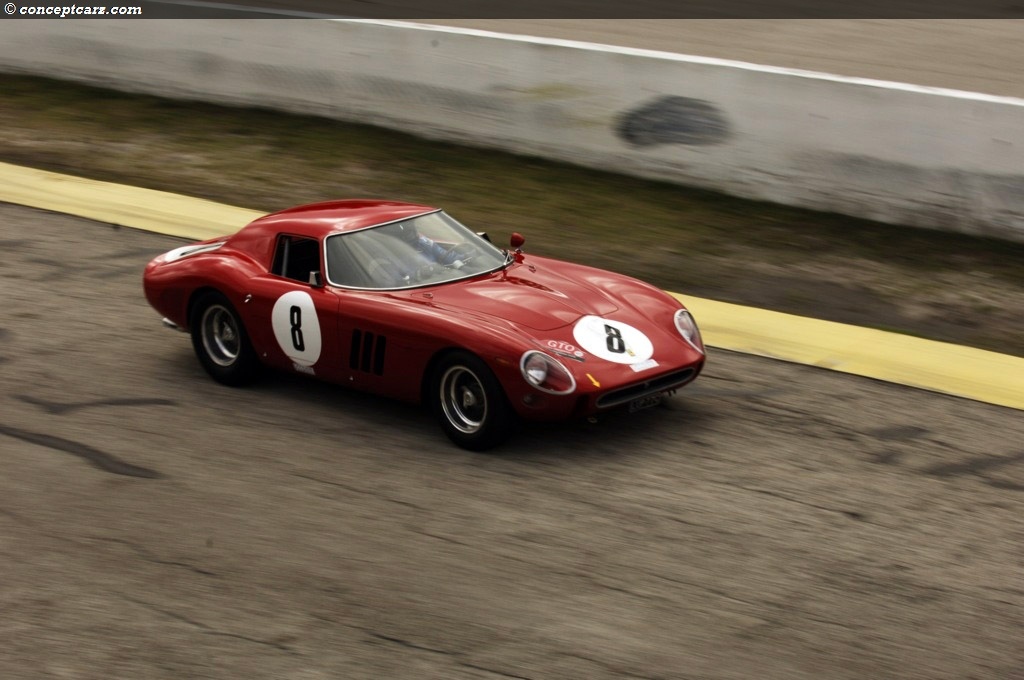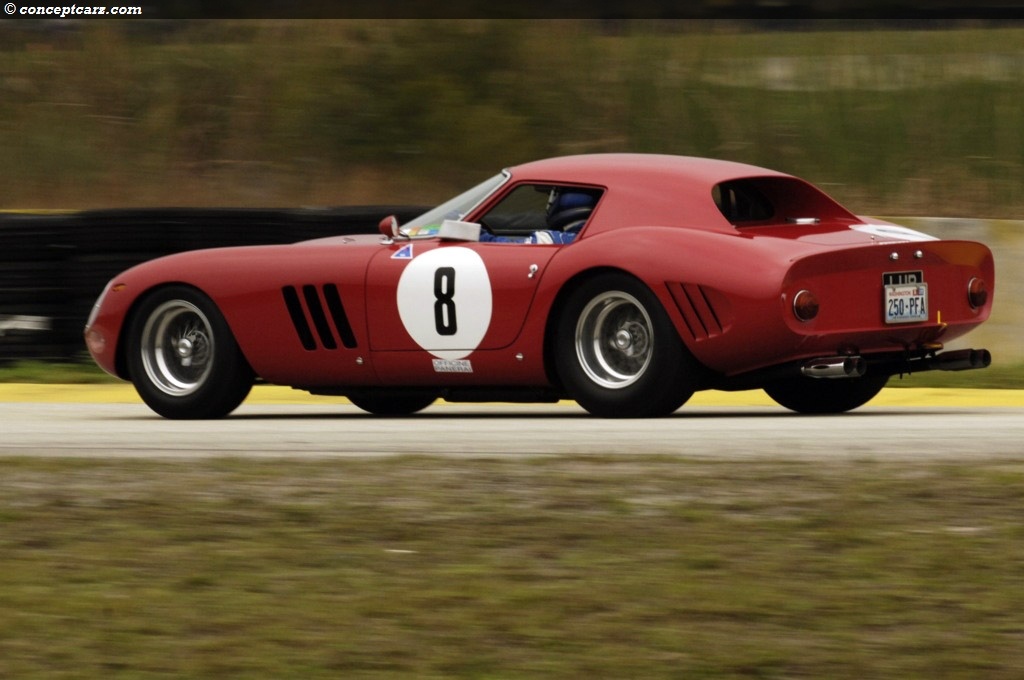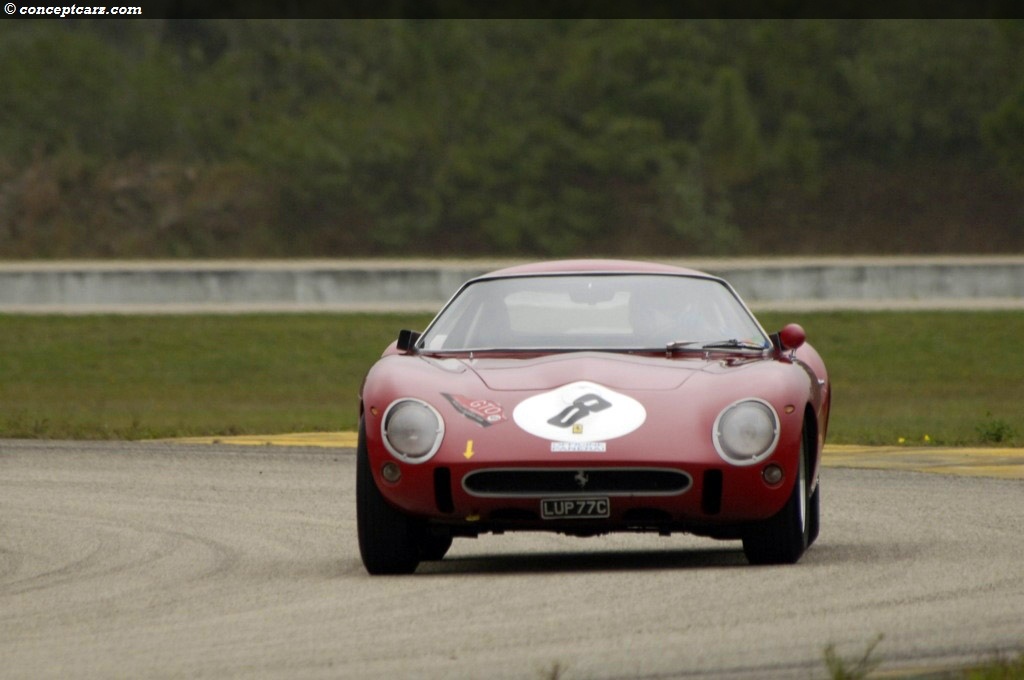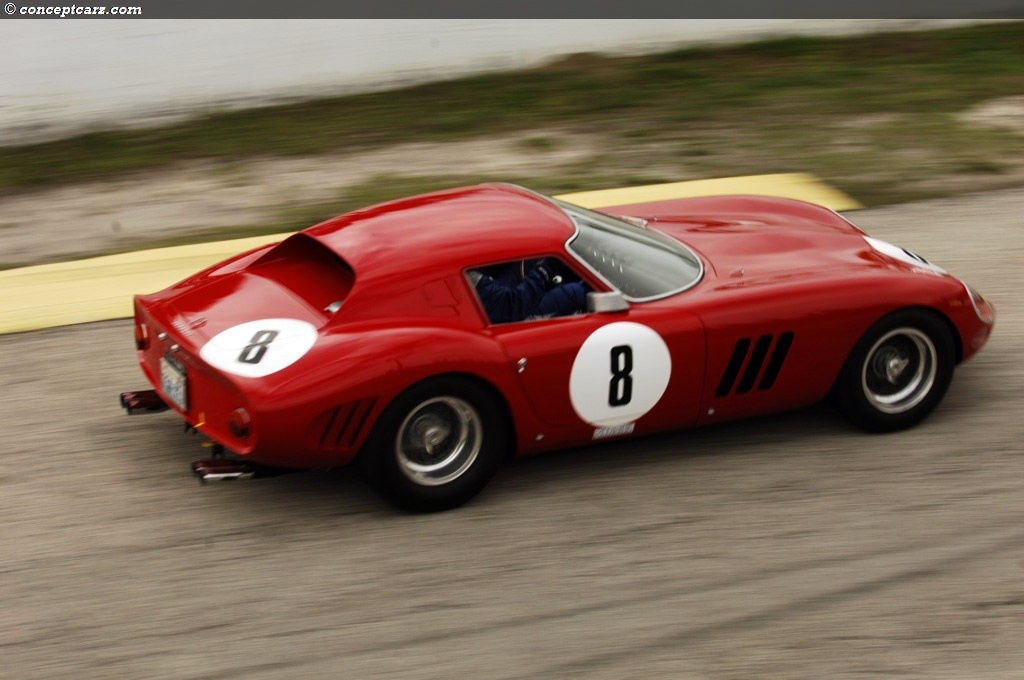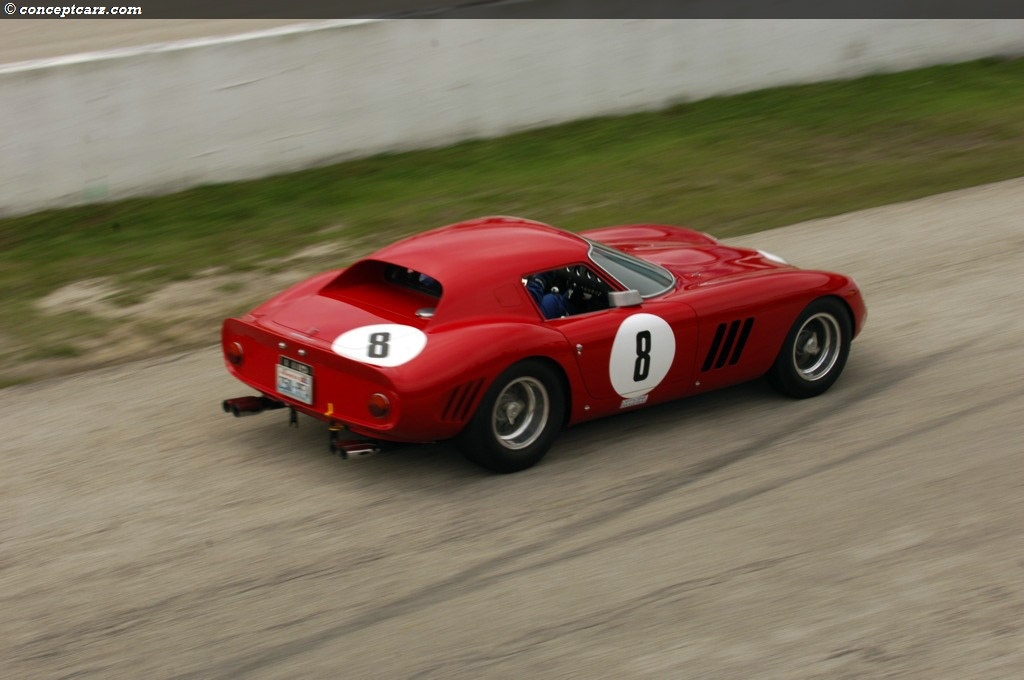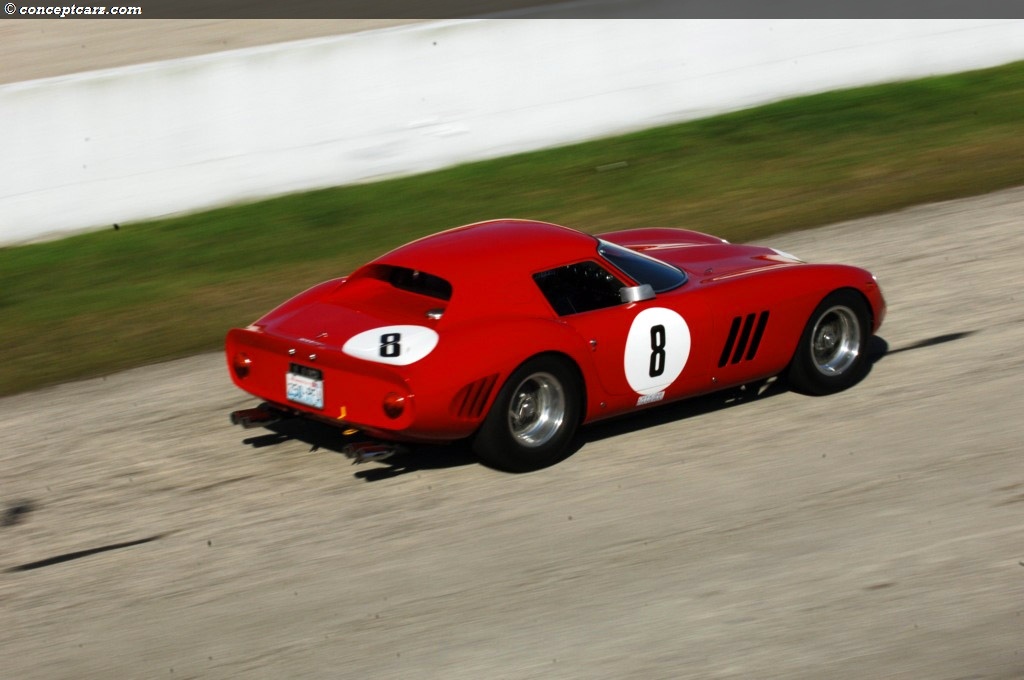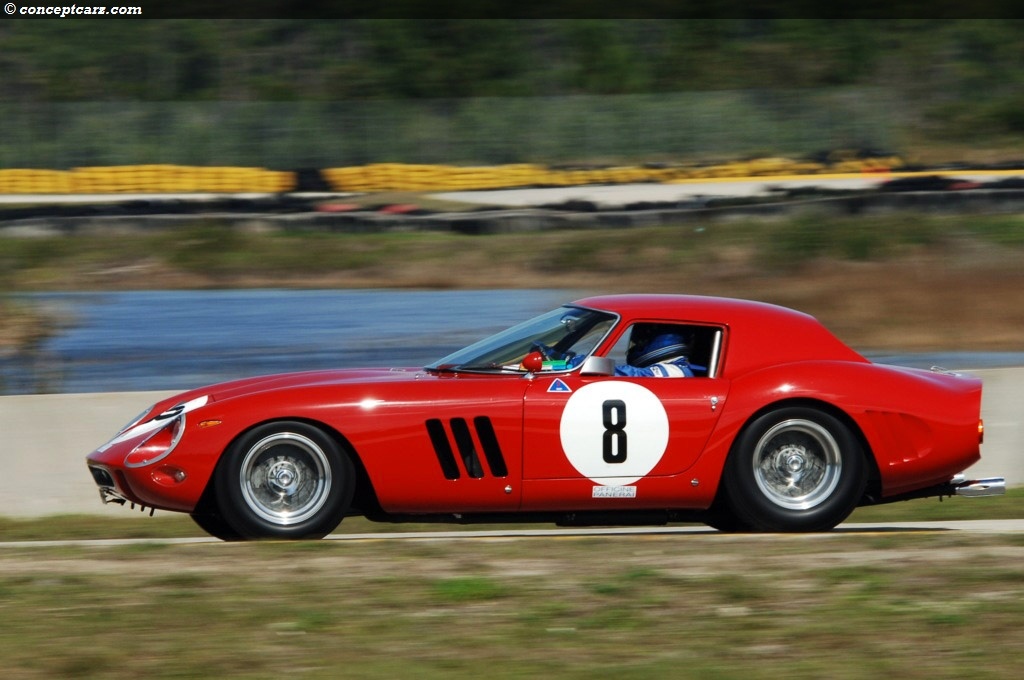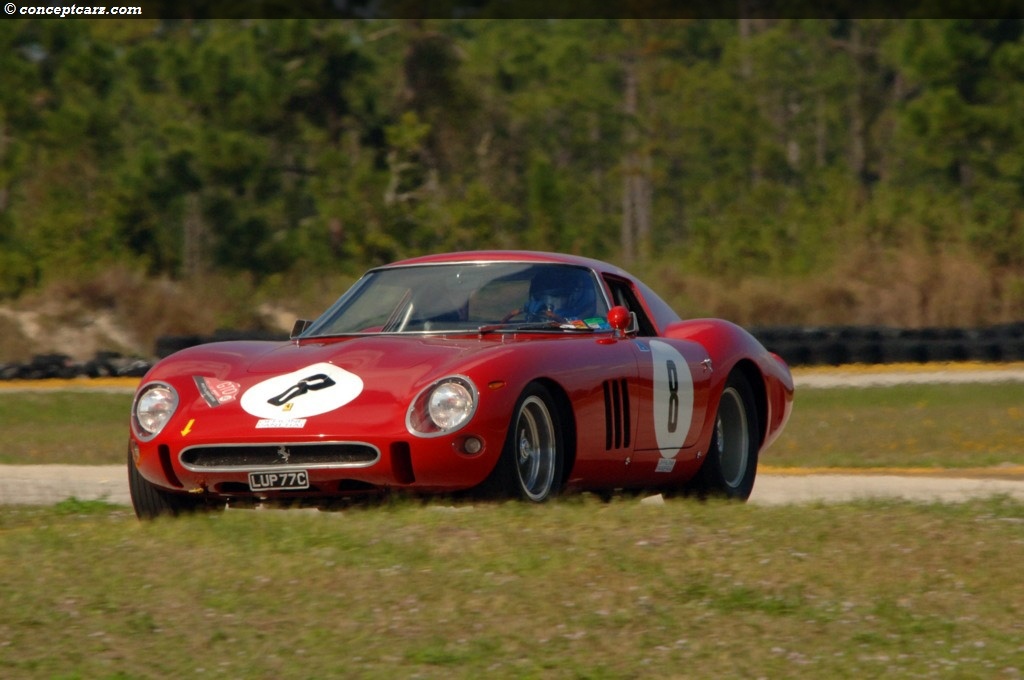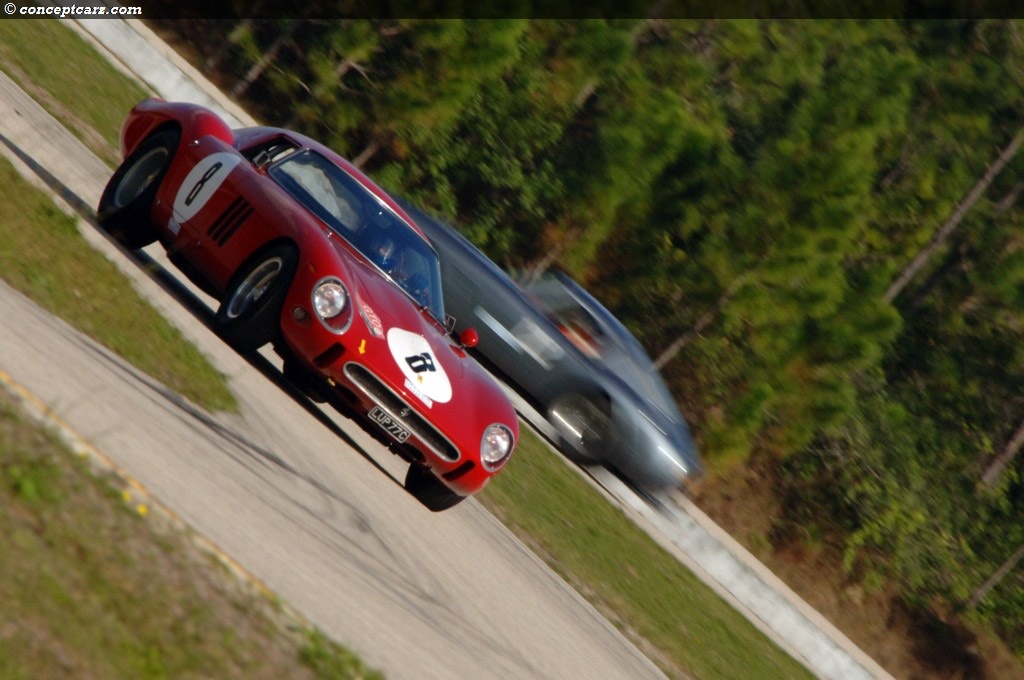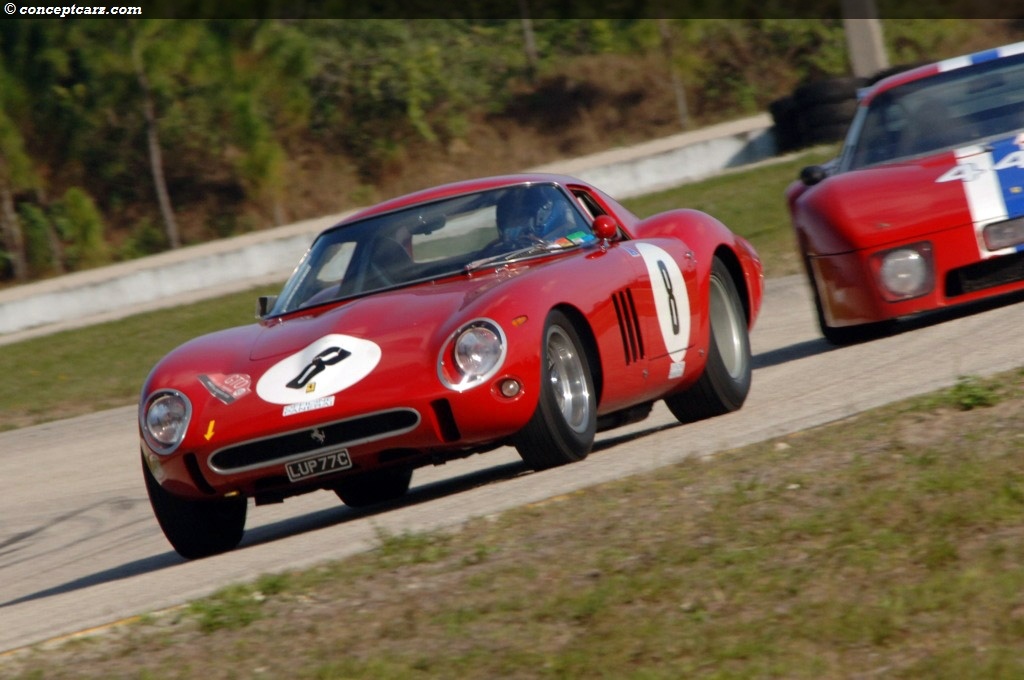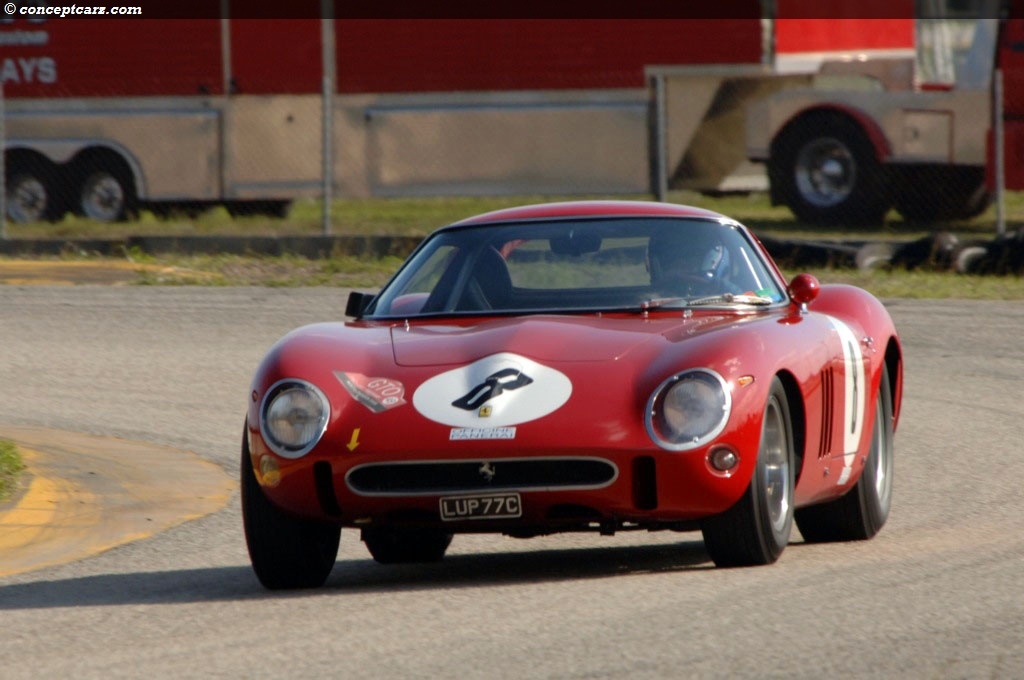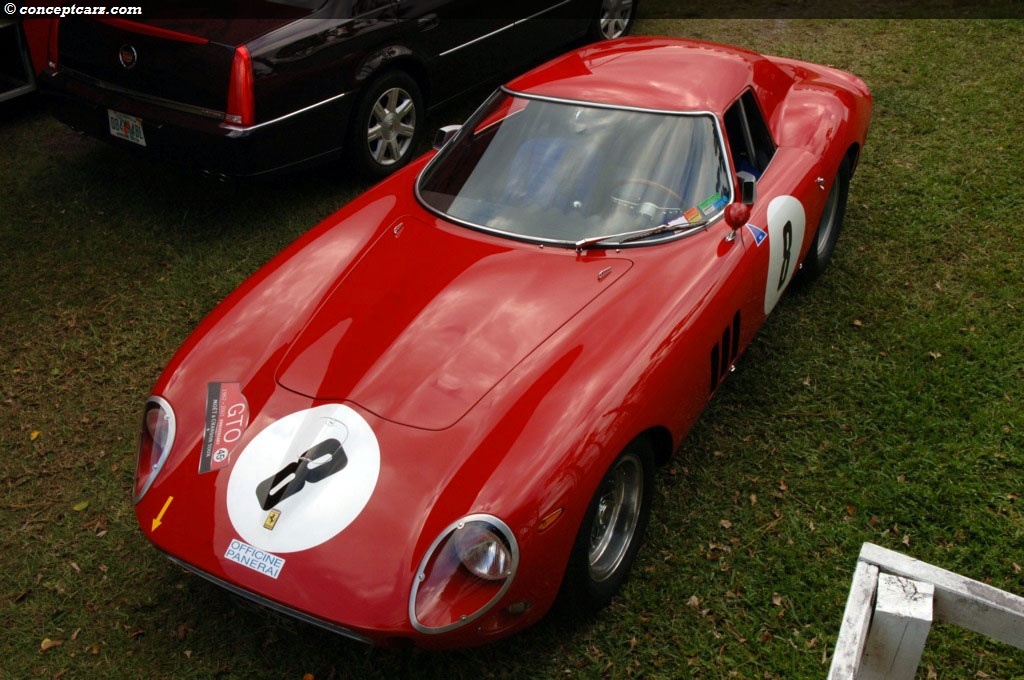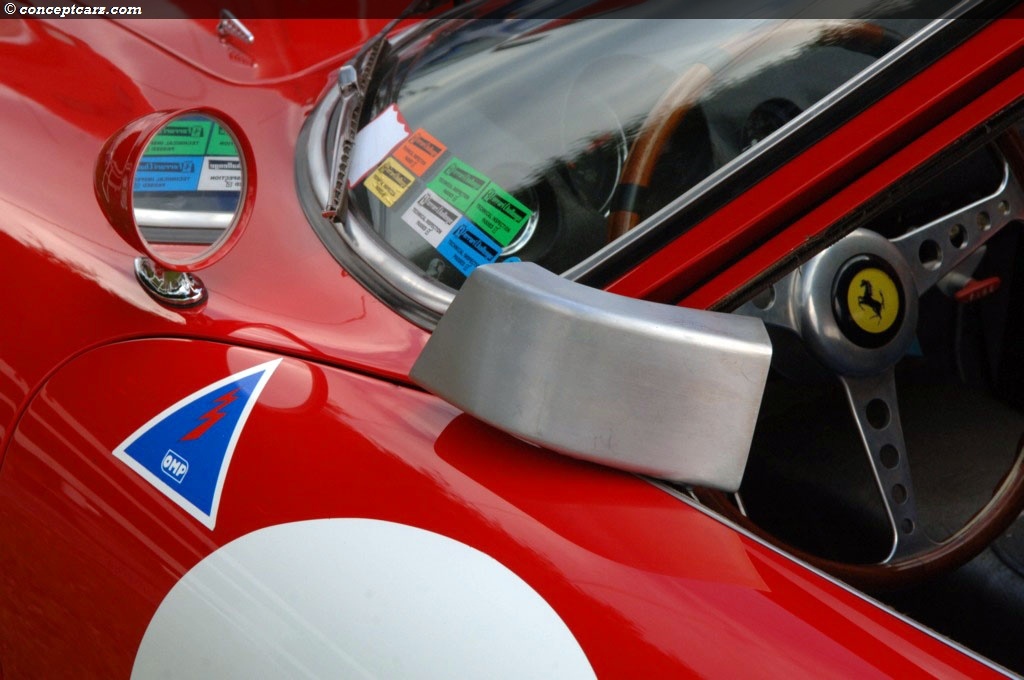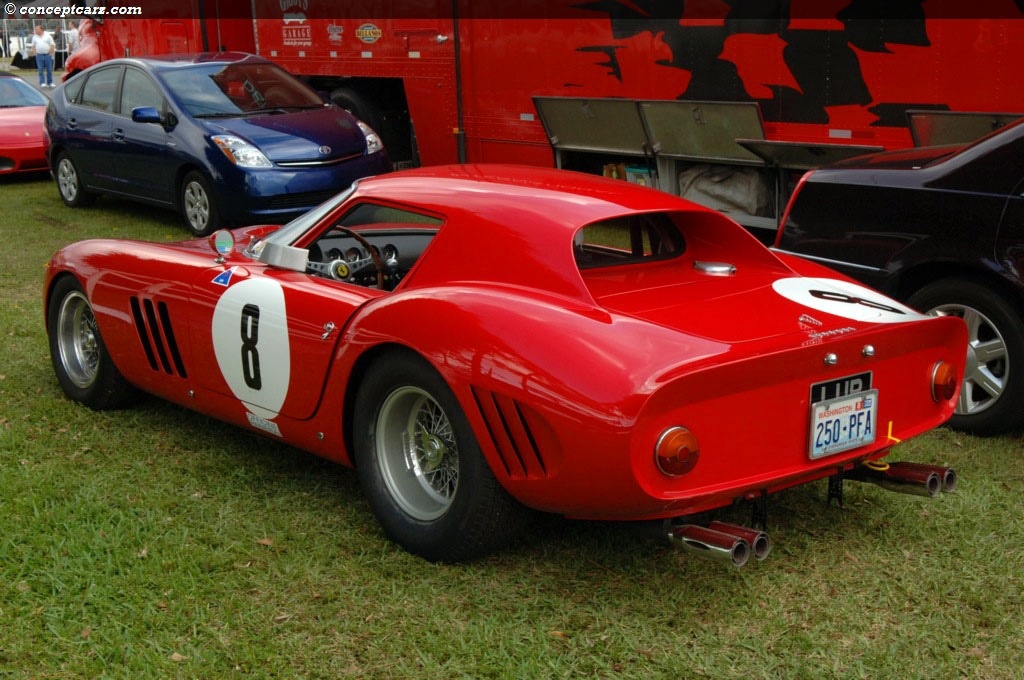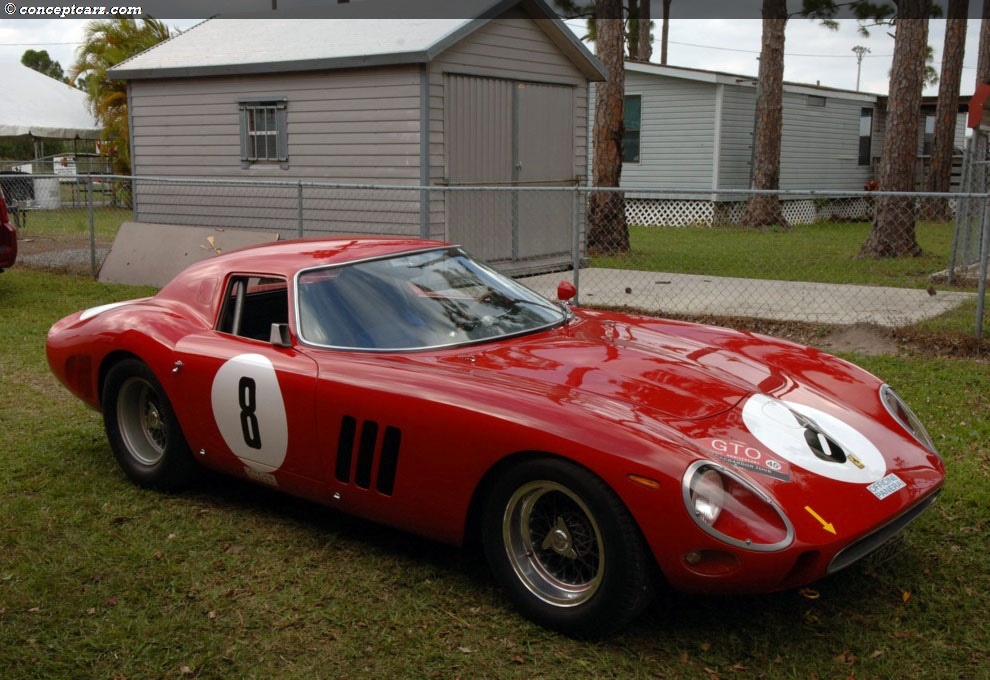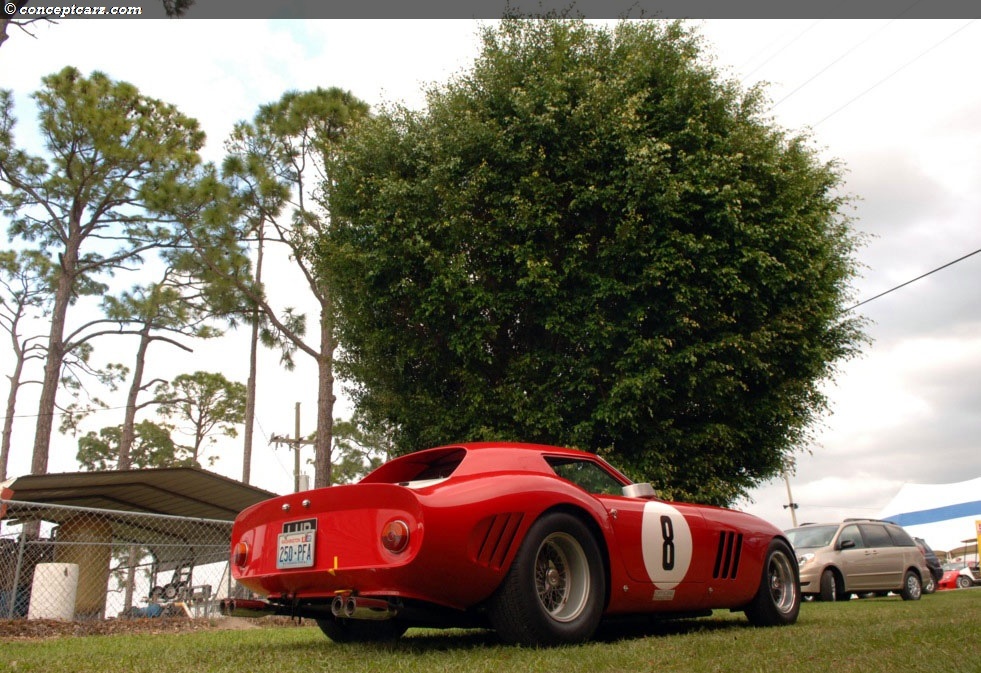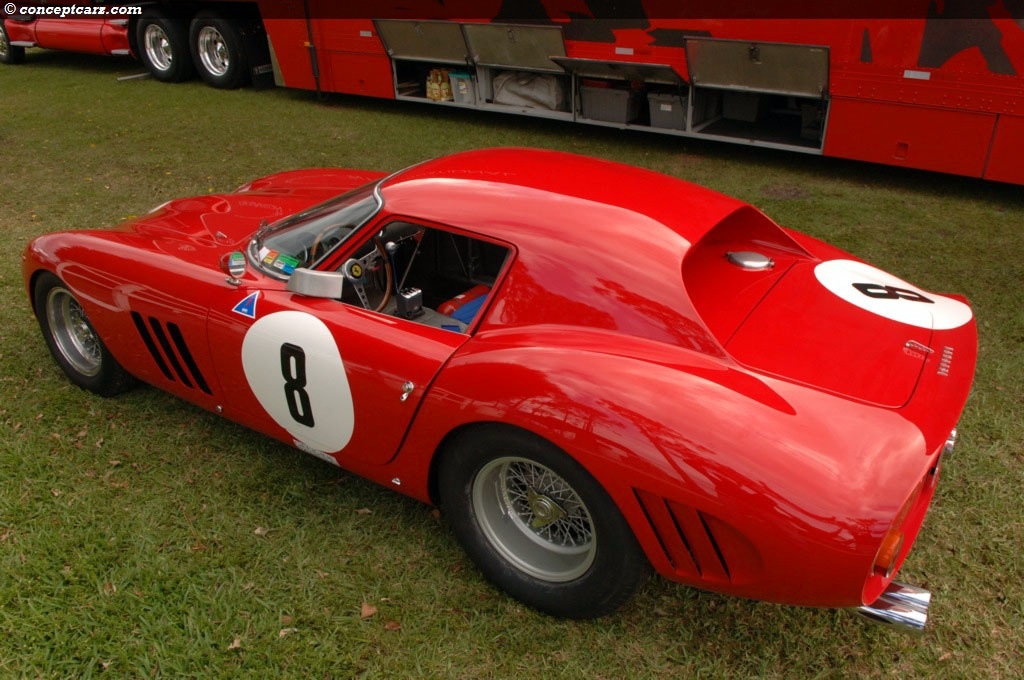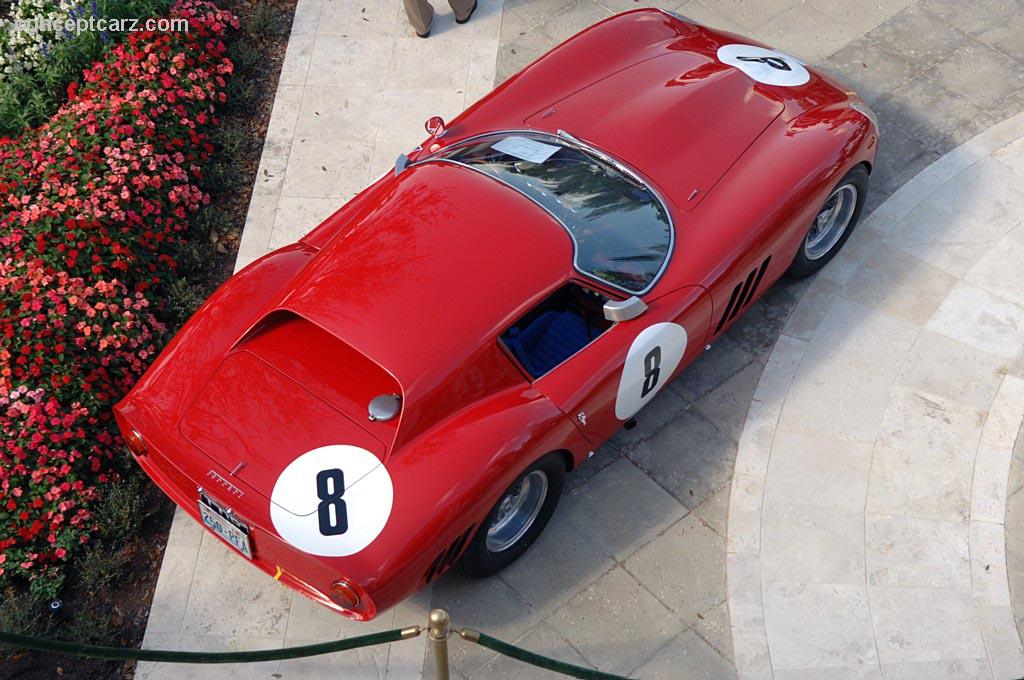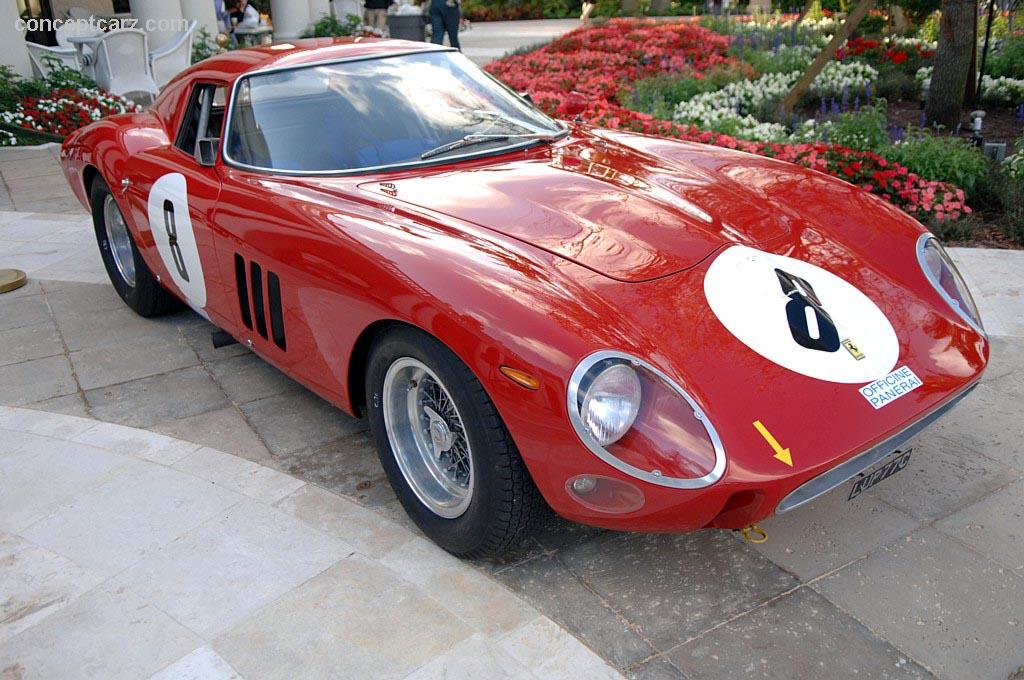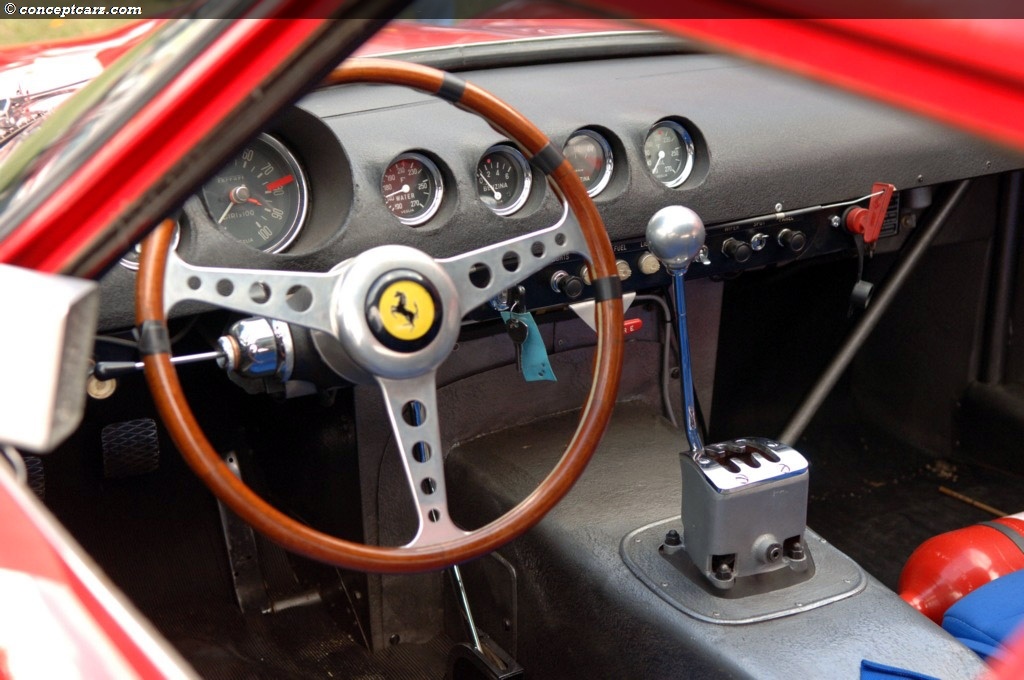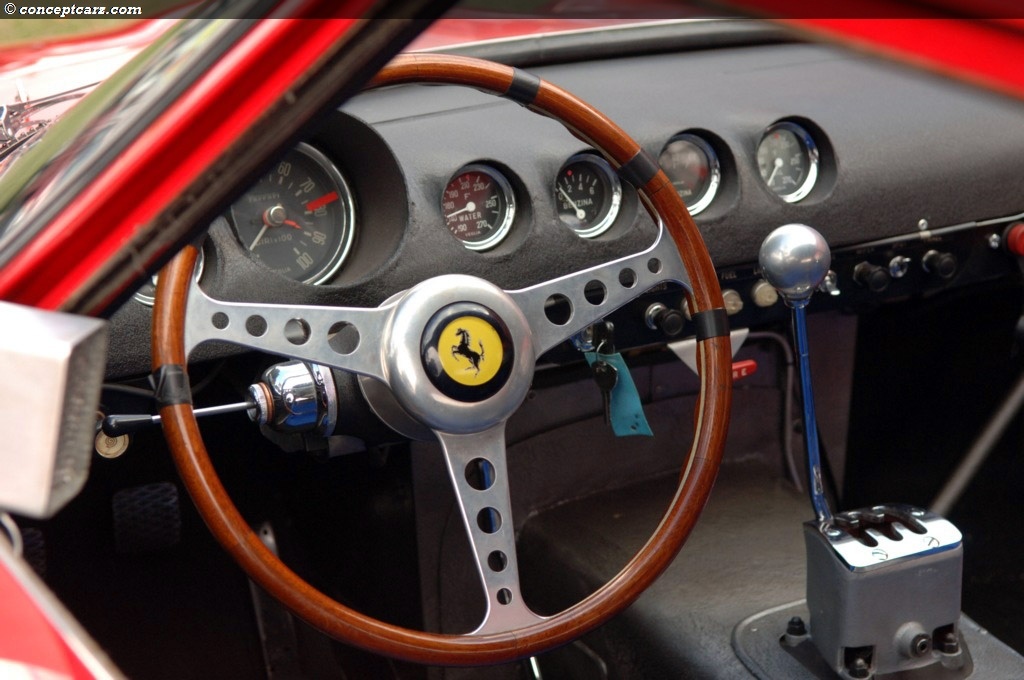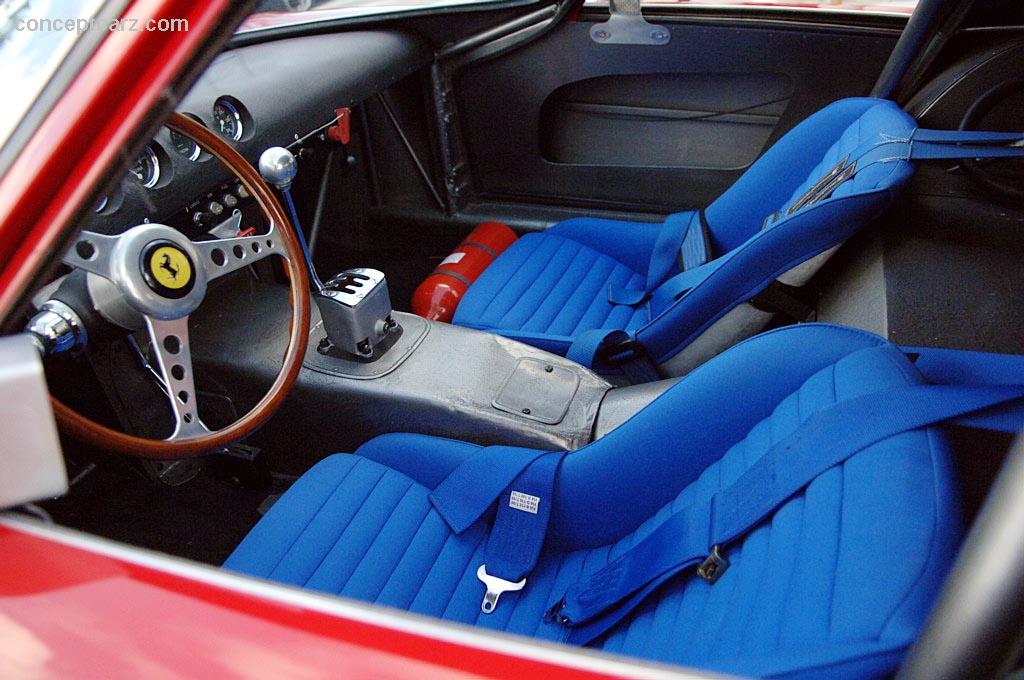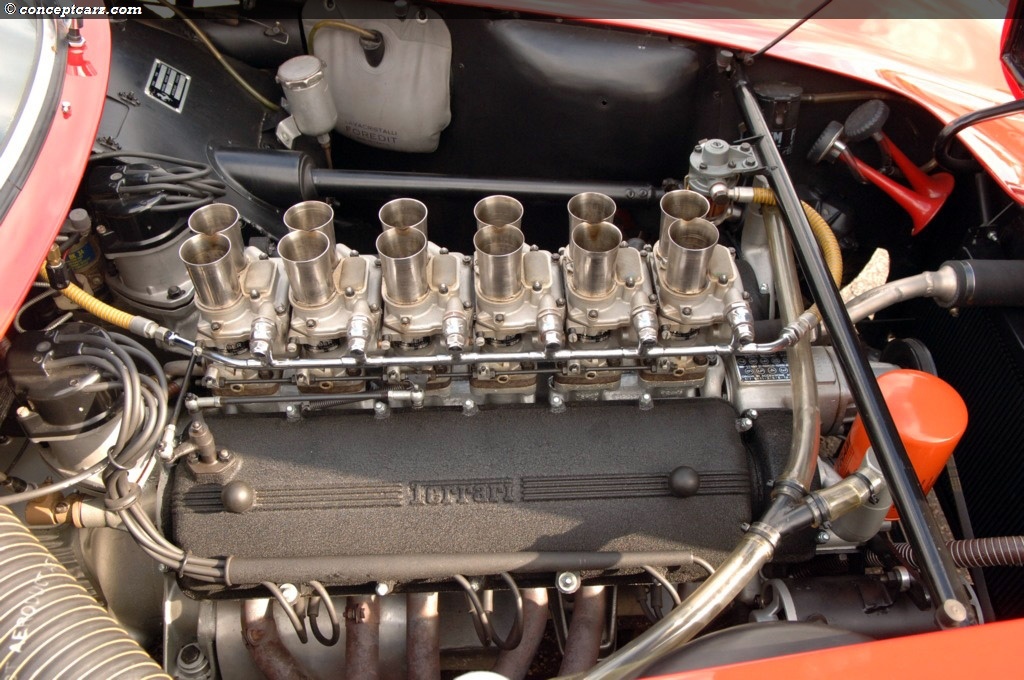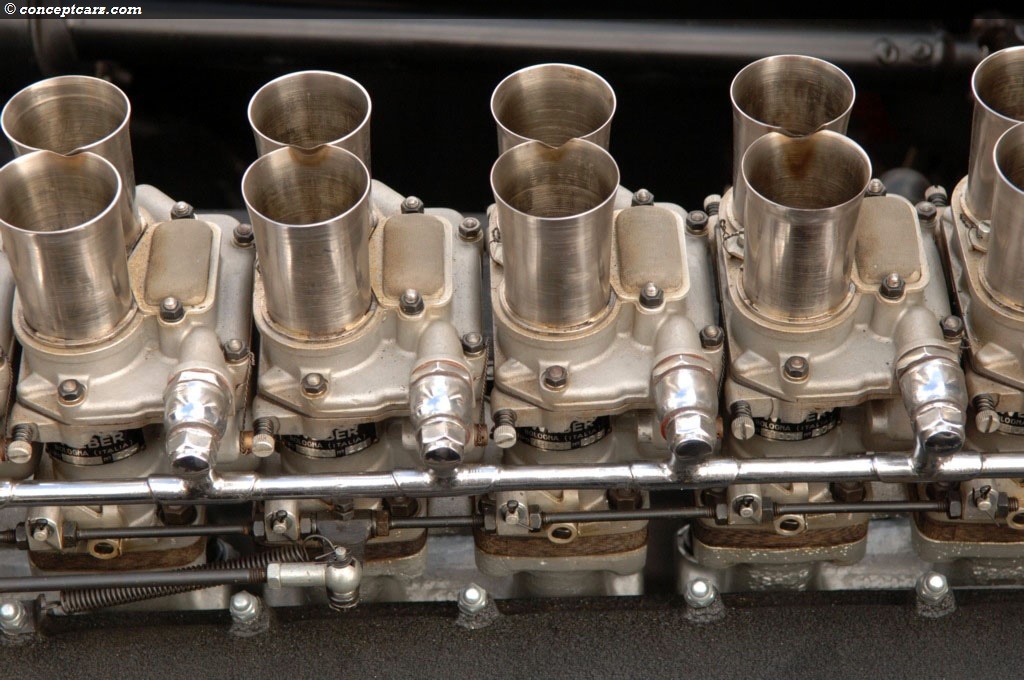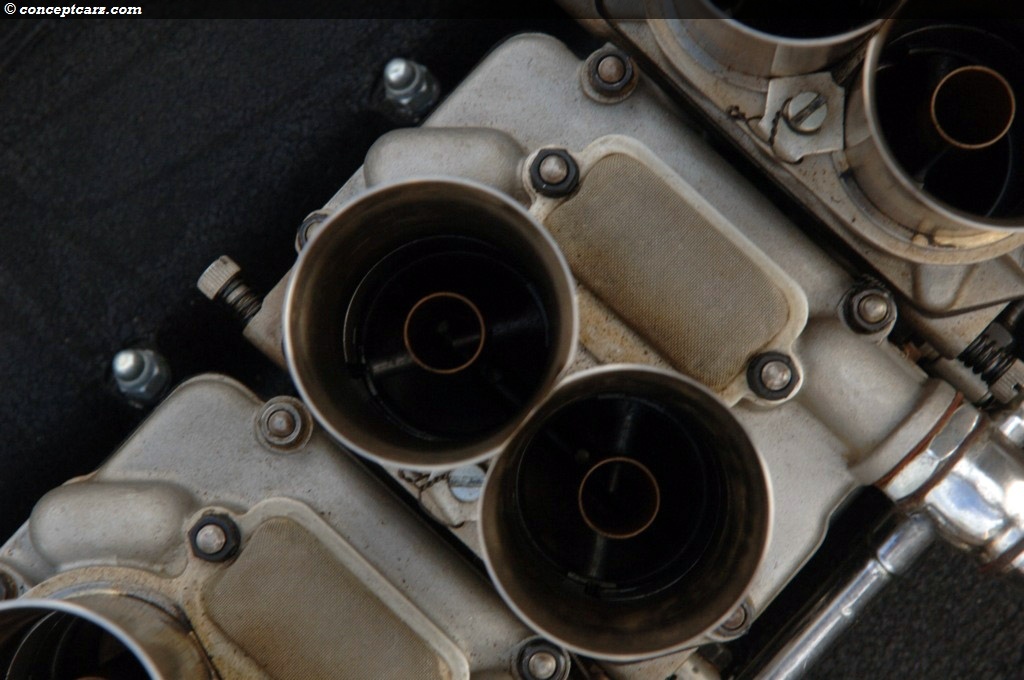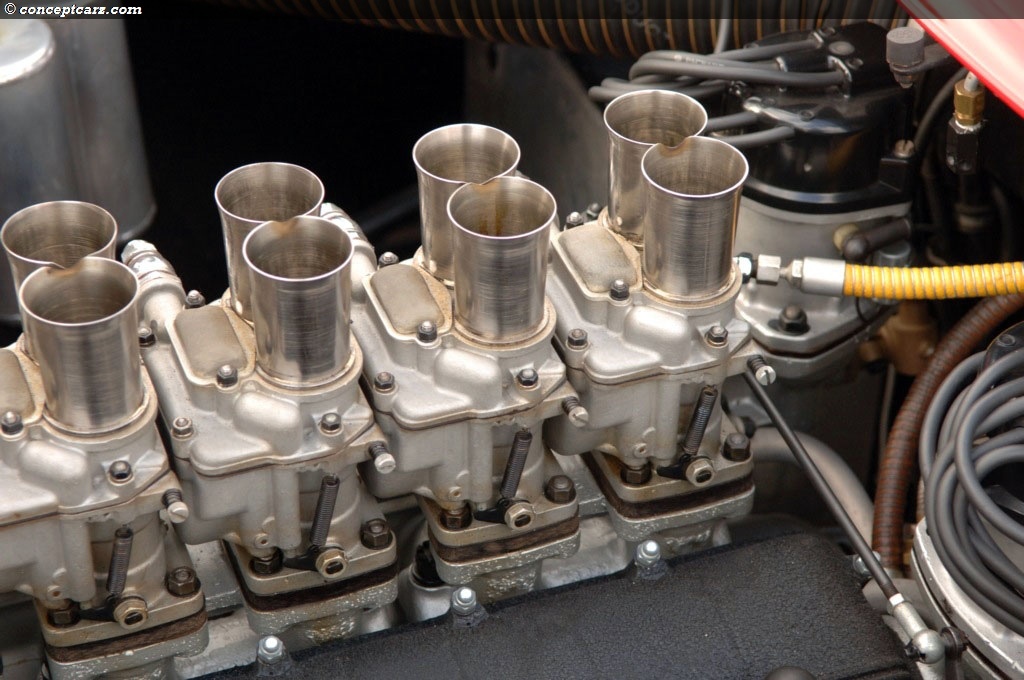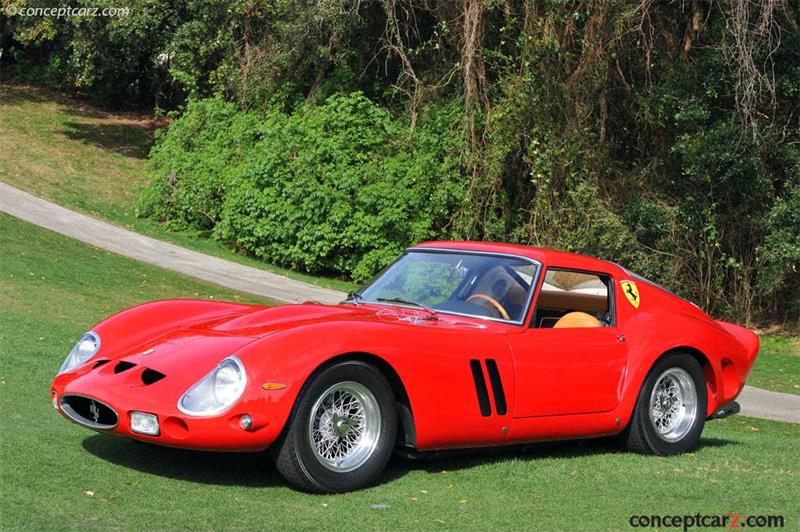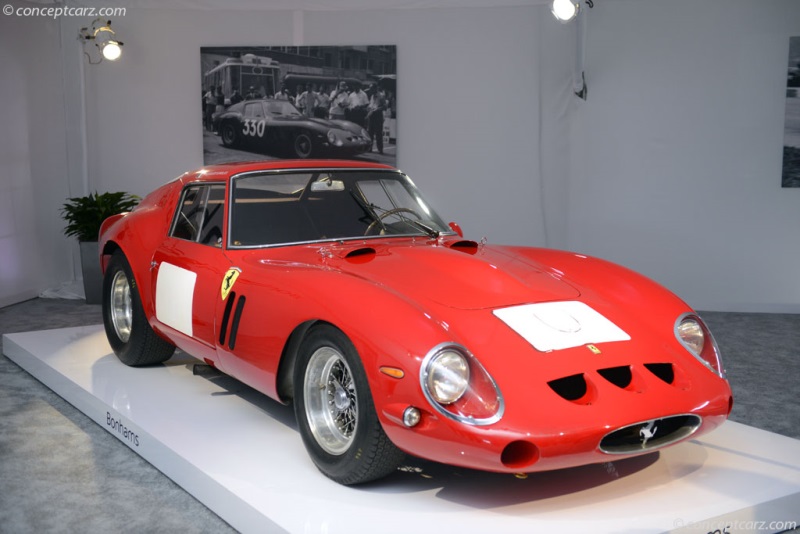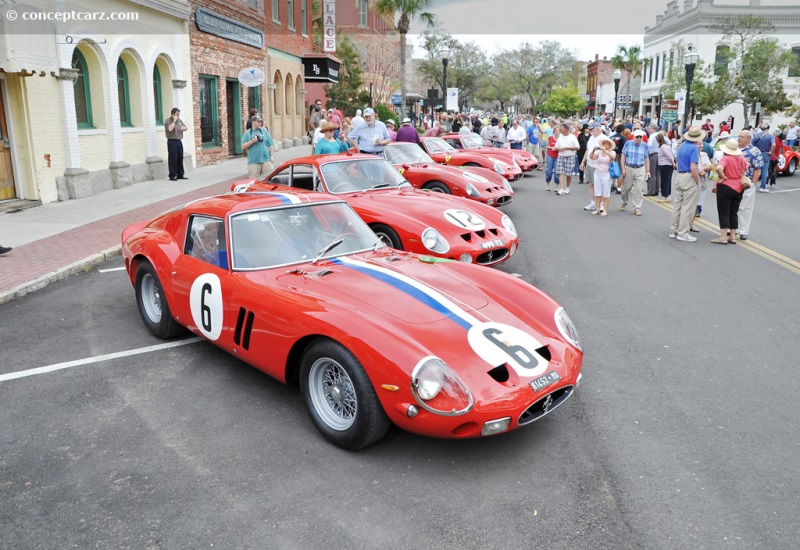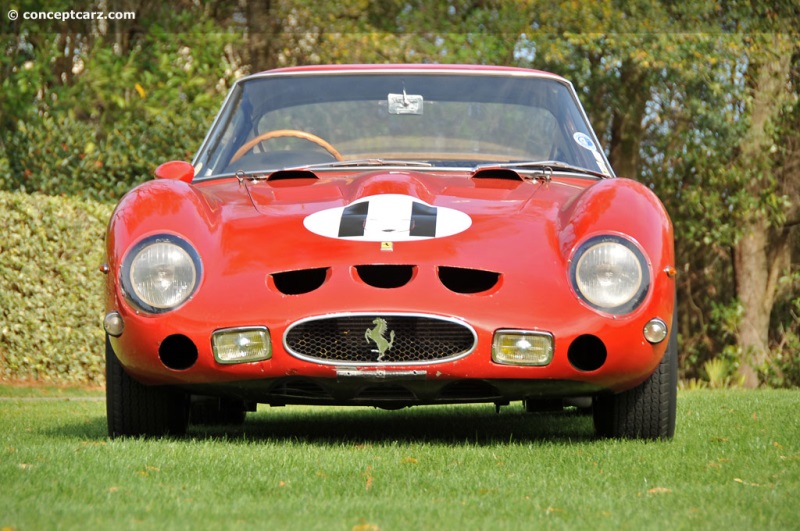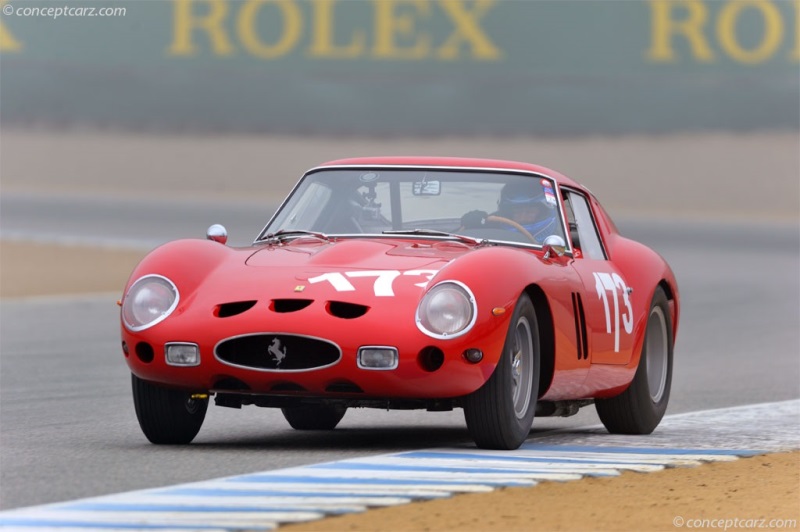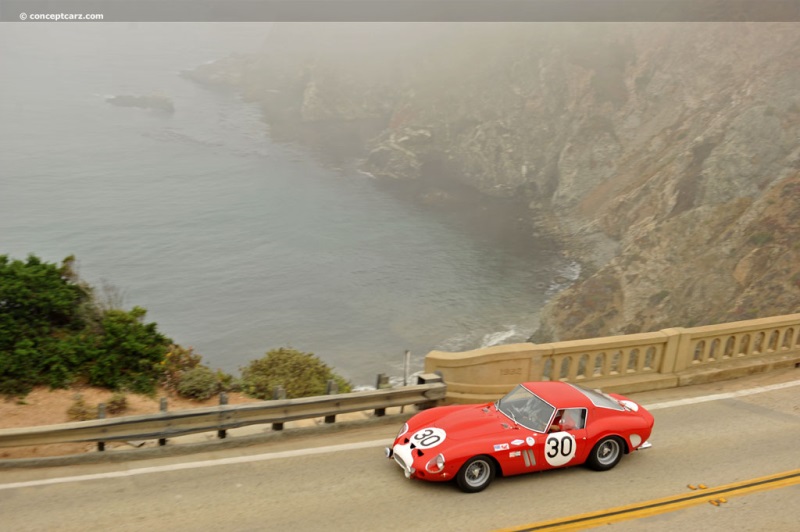Image credit: © conceptcarz.com (Reproduction Or reuse prohibited).
This Ferrari 250 GTO is the third production GTO built. It was built in late April of 1962 and was the first GTO to wear Series I coachwork details which include the small radiator intake, narrow brake ducts, sail-panel vents, and hood fasteners. It also had bolted-on rear spoiler and turn signal lamps located below the headlights. Power was from the tipo 168/62 competizione V-12. The exterior was finished in rosso cina, and the interior was finished in blue cloth upholstery.
In May of 1962, it was driven by Phil Hill as SEFAC Ferrari's official practice car for the upcoming Targa Florio. A few days later it was sold to Mrs. Arnalda Colombo, who purchased the car on behalf of her husband, Edoardo Lualdi-Gabardi. Mr. Lualdi-Gabardi's racing career included no fewer than 116 victories or class wins.
Lualdi-Gabardi campaigned 3413 in Italian hill climbs, starting with a victory at the Coppa Citta Asiago on May 13th. Many class wins followed during the next month at hill climbs at Bologna-Raticosa, the Coppa Consuma, Bolzano-Mendola, and Trento-Bondone. Outright victories followed, beginning with the Trieste–Opicina hill climb on July 22nd, followed by the Trofeo Sarezzo-Lumezzane and the Coppa Faglioli in September, and the Coppa Autunno at Monza in October. At the end of the season, Lualdi-Gabardi and 3413 were awarded the class champion for the 1962 Italian GT Championship.
In April of 1963, the car earned a final overall victory with Lualdi-Gabardi at the Stallavena-Bosco Chiesanuova hill climb. Four days later, it was sold to its second owner, Gianni Bulgari. Bulgari entered the car at the Targa Florio on May 5th, where it finished 1st in class and 4th overall, with Maurizio Grana as his co-pilot. Six months later he won the Coppa FISA at Monza.
For the 1964 season, Ferrari was the defending victor, having earned the International Championship for GT Manufacturers in both 1962 and 1963 in the over-two-liter category, thanks in-part to the GTO. Additional rules and adjustments were made by the FIA for the 1964 season, resulting in classes of 'under two liters' and 'over two liters,' meaning the 'over' included over-three-liter cars. This change introduced much stiffer competition for Ferrari, placing the GTO against much larger capacity and lightweight vehicles. Since the 250 LM was denied homologation status, the 250 GTO was used for another season.
The Targa Florio was the third race in the Championship. Ferrari had won both at Daytona and Sebring, and without the factory fielding their own Works entries, the Targa Florio was left to the Ferrari privateers.
1962 Ferrari GTO with chassis number 3413 was acquired by Corrado Ferlaino in December of 1963, before the start of the season. The car had successful hill climb history and Series I bodywork. In January of 1964, the car was sent by the factory to Scaglietti in Modena, where its bodywork was upgraded to Series II coachwork with no spoiler. The design, courtesy of Pininfarina, offered improved aerodynamics. It was lower, wider, shorter, larger tires, wider track, and with more steeply raked windshield. Additionally, the engine sat lower, helping to improve balance and handling.
Three other Series I coachwork cars were later upgraded to Series II configuration in period. Two of those, including this car, were given the extended roofline in similar fashion to the 250 LM.
At the 1964 Targa Florio, chassis number 3413 was driven by Ferlaino and Taramazzo to a 5th place overall finish. It was one of 28 cars to finish the race, with over 30 cars forced to retire from the grueling event. Ferlaino would race the 250 at least three more times in 1964, with a class win at the Bologna-Raticosa Hill Climb in late May and 3rd overall at the Mugello 500 KM a month later.
The car's next owner was Dan Margulies, a dealer living in London. Prior to December of 1965, the front coachwork around the nose was slightly modified, with twin vertical vents for brake cooling. Near the close of December of 1965, it was driven by David Piper in the Redex Trophy at Brands Hatch where he finished in first place. This would be the car's final race in period.
The GTO was sold by Margulies to Jack Le Fort in 1967. It was driven twice at the Prescott Speed Hill Climb before it was sold a year later to Neil Corner. In 1970, Mr. Corner entered the car in a race held in conjunction with the Bugatti Drivers Club Meeting at Silverstone. Shortly afterward, it was acquired by Lord Anthony Bamford of Stoke-on-Trent. In the 1980s, it was sold to Nigel Moores. In 1988, it was sold to Japanese collector Yoshijuki Hayashi, though the car remained domiciled in the UK. During this ownership, the car participated in European vintage events, including the GTO 30th Anniversary Tour in September 1992, and the Goodwood Festival of Speed in June 1993 - where it was driven by Tony Merrick in both events.
In April of 1994, it was purchased from Hayashi by Sir Lindsay Owen-Jones of London. In January of 2000, it entered the care of its current owner. Since then it has been shown, raced, and rallied at premium vintage events. It made four appearances at the Cavallino Classic between 2001 and 2008 and four seasons in the Shell Ferrari Historic Challenge between 2001 and 2009. It participated in the GTO 40th Anniversary tour in September 2002; the Monterey Historic Races in August 2004, 2008, and 2011; the GTO 45th Anniversary tour in 2007; the Goodwood Revival Meeting in 2011; and the GTO 50th and 55th Anniversary tours, respectively, held in 2012 and 2017. In 2011 it was shown at the Pebble Beach Concours d'Elegance.By Daniel Vaughan | Jan 2019
In May of 1962, it was driven by Phil Hill as SEFAC Ferrari's official practice car for the upcoming Targa Florio. A few days later it was sold to Mrs. Arnalda Colombo, who purchased the car on behalf of her husband, Edoardo Lualdi-Gabardi. Mr. Lualdi-Gabardi's racing career included no fewer than 116 victories or class wins.
Lualdi-Gabardi campaigned 3413 in Italian hill climbs, starting with a victory at the Coppa Citta Asiago on May 13th. Many class wins followed during the next month at hill climbs at Bologna-Raticosa, the Coppa Consuma, Bolzano-Mendola, and Trento-Bondone. Outright victories followed, beginning with the Trieste–Opicina hill climb on July 22nd, followed by the Trofeo Sarezzo-Lumezzane and the Coppa Faglioli in September, and the Coppa Autunno at Monza in October. At the end of the season, Lualdi-Gabardi and 3413 were awarded the class champion for the 1962 Italian GT Championship.
In April of 1963, the car earned a final overall victory with Lualdi-Gabardi at the Stallavena-Bosco Chiesanuova hill climb. Four days later, it was sold to its second owner, Gianni Bulgari. Bulgari entered the car at the Targa Florio on May 5th, where it finished 1st in class and 4th overall, with Maurizio Grana as his co-pilot. Six months later he won the Coppa FISA at Monza.
For the 1964 season, Ferrari was the defending victor, having earned the International Championship for GT Manufacturers in both 1962 and 1963 in the over-two-liter category, thanks in-part to the GTO. Additional rules and adjustments were made by the FIA for the 1964 season, resulting in classes of 'under two liters' and 'over two liters,' meaning the 'over' included over-three-liter cars. This change introduced much stiffer competition for Ferrari, placing the GTO against much larger capacity and lightweight vehicles. Since the 250 LM was denied homologation status, the 250 GTO was used for another season.
The Targa Florio was the third race in the Championship. Ferrari had won both at Daytona and Sebring, and without the factory fielding their own Works entries, the Targa Florio was left to the Ferrari privateers.
1962 Ferrari GTO with chassis number 3413 was acquired by Corrado Ferlaino in December of 1963, before the start of the season. The car had successful hill climb history and Series I bodywork. In January of 1964, the car was sent by the factory to Scaglietti in Modena, where its bodywork was upgraded to Series II coachwork with no spoiler. The design, courtesy of Pininfarina, offered improved aerodynamics. It was lower, wider, shorter, larger tires, wider track, and with more steeply raked windshield. Additionally, the engine sat lower, helping to improve balance and handling.
Three other Series I coachwork cars were later upgraded to Series II configuration in period. Two of those, including this car, were given the extended roofline in similar fashion to the 250 LM.
At the 1964 Targa Florio, chassis number 3413 was driven by Ferlaino and Taramazzo to a 5th place overall finish. It was one of 28 cars to finish the race, with over 30 cars forced to retire from the grueling event. Ferlaino would race the 250 at least three more times in 1964, with a class win at the Bologna-Raticosa Hill Climb in late May and 3rd overall at the Mugello 500 KM a month later.
The car's next owner was Dan Margulies, a dealer living in London. Prior to December of 1965, the front coachwork around the nose was slightly modified, with twin vertical vents for brake cooling. Near the close of December of 1965, it was driven by David Piper in the Redex Trophy at Brands Hatch where he finished in first place. This would be the car's final race in period.
The GTO was sold by Margulies to Jack Le Fort in 1967. It was driven twice at the Prescott Speed Hill Climb before it was sold a year later to Neil Corner. In 1970, Mr. Corner entered the car in a race held in conjunction with the Bugatti Drivers Club Meeting at Silverstone. Shortly afterward, it was acquired by Lord Anthony Bamford of Stoke-on-Trent. In the 1980s, it was sold to Nigel Moores. In 1988, it was sold to Japanese collector Yoshijuki Hayashi, though the car remained domiciled in the UK. During this ownership, the car participated in European vintage events, including the GTO 30th Anniversary Tour in September 1992, and the Goodwood Festival of Speed in June 1993 - where it was driven by Tony Merrick in both events.
In April of 1994, it was purchased from Hayashi by Sir Lindsay Owen-Jones of London. In January of 2000, it entered the care of its current owner. Since then it has been shown, raced, and rallied at premium vintage events. It made four appearances at the Cavallino Classic between 2001 and 2008 and four seasons in the Shell Ferrari Historic Challenge between 2001 and 2009. It participated in the GTO 40th Anniversary tour in September 2002; the Monterey Historic Races in August 2004, 2008, and 2011; the GTO 45th Anniversary tour in 2007; the Goodwood Revival Meeting in 2011; and the GTO 50th and 55th Anniversary tours, respectively, held in 2012 and 2017. In 2011 it was shown at the Pebble Beach Concours d'Elegance.By Daniel Vaughan | Jan 2019
2018 RM Sothebys : Monterey
Pre-Auction Estimates :
USD $45,000,000-USD $60,000,000
Sale Price :
USD $48,405,000
Recent Sales of the Ferrari 250 GTO
(Data based on Model Year 1962 sales)
| 1962 Ferrari 250 GTO by Scaglietti Chassis#: 3413 Sold for USD$48,405,000 2018 RM Sothebys : Monterey |   |
| 1962-63 FERRARI 250 GTO BERLINETTA Chassis#: 3851GT Sold for USD$38,115,000 2014 Bonhams Quail Lodge Auction |   |
Ferrari 250 GTOs That Failed To Sell At Auction
1962 Ferrari 250 GTO's that have appeared at auction but did not sell.
| Vehicle | Chassis | Event | High Bid | Est. Low | Est. High |
|---|
Vehicles With Comparable Market Values
Similar sales to the $43,260,000 range.
1962 Ferrari 250 GTO
• Additional valuation insight and sales data• History
• Specifications
• Image gallery
• Other Ferrari 250 GTO model years
